With most automobile manufacturers launching plug-in hybrid (PHEV) or fully electric SUV models, no one has launched a new inline 6-cylinder petrol engine for a few years. It seemed strange and it was quite a shock to many industry watchers that any brand would even consider designing and building an all-new inline six-cylinder engine in 2023 – but Mazda has done just that.
Along with the all-new six-cylinder, the CX-60 is also available in a 2.5-litre, 4-cylinder PHEV model. DriveLife went to the launch of the all-new CX-60 and only got time to drive the six-cylinder 3.3-litre model, so Mazda offered both the PHEV and 3.3 models to test, back to back. This will make a great comparison, especially around fuel consumption and smoothness. Mazda is well known for making exceptionally refined cars, and we hope that the CX-60 will continue that trend.
Recently, Ken Sailto from DriveLife took a CX-60 to Greece for a first drive, and you can read about his impressions of the car here.
We’d be testing the PHEV model for a week, and then jumping into the 3.3-litre model for a week and taking it on a 700km trip to Hawera and back, to work on our project car.
Ride with us as we test Mazda’s all-new mid-size SUV out for a decent amount of miles.
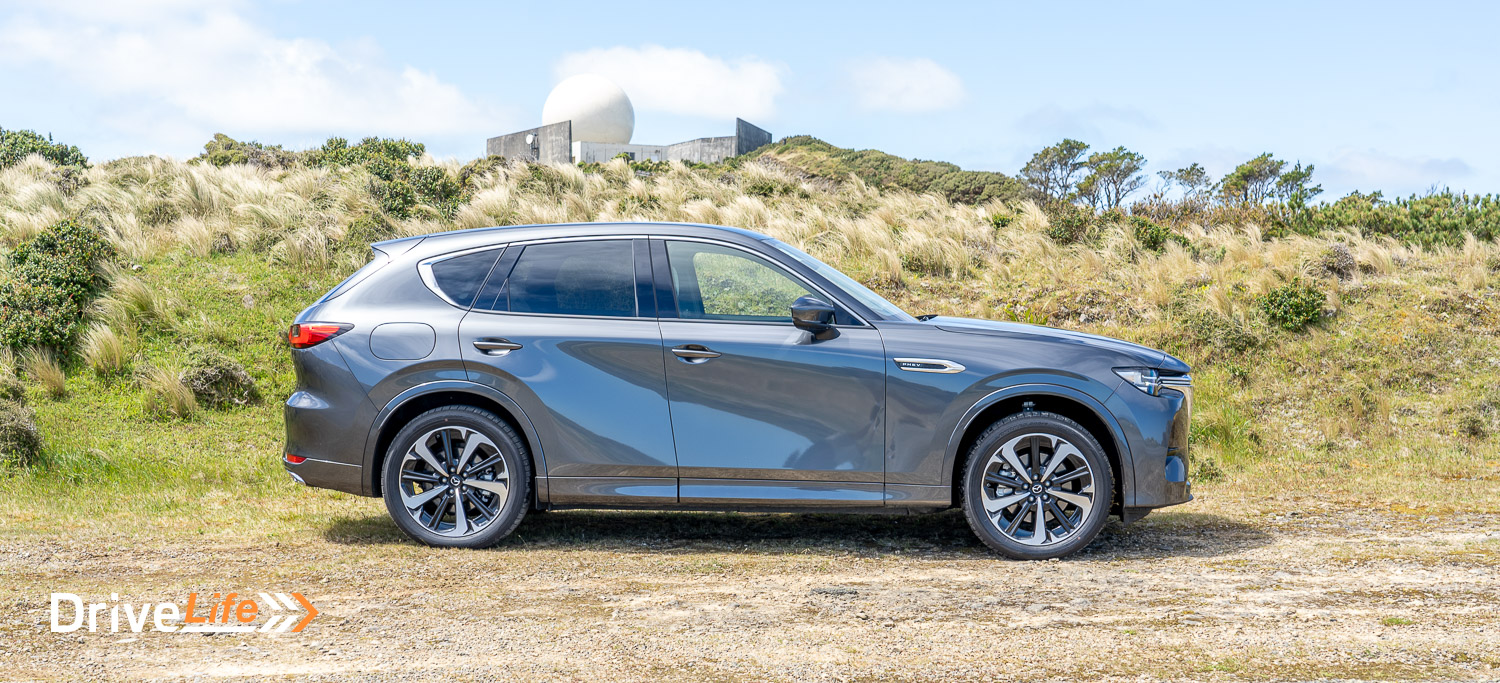
What We Like and Dislike About The 2023 Mazda CX-60
| What we like | What we don’t like |
| Interior luxury Interior finish Interior materials Equipment levels Camera system clarity Engine noise (3.3) Adaptive cruise control smoothness Fuel economy (both models) Handling overall Styling Performance of both engines Infotainment speed | Fake exhaust tips Drivetrain shunting (both models) Adaptive cruise on corners Light regen (PHEV) |
What’s In The 2023 Mazda CX-60 Range?
All CX-60 models are all-wheel-drive and you can choose from two drivetrains, although you can only get the 3.3-litre motor in Homura Spec.
The 3.3-litre model has an inline six cylinder, turbocharged petrol engine that outputs 209kW of power and 450Nm of torque. The PHEV model has a 2.5-litre, 4-cylinder engine with a 17.8kWh battery pack and manages 241kW of power and 500Nm of torque. Both powertrains are mated to an all-new 8-speed automatic transmission.
There are four CX-60 models to choose from:
- Touring PHEV
- Homura PHEV
- Homura 3.3
- Takami PHEV
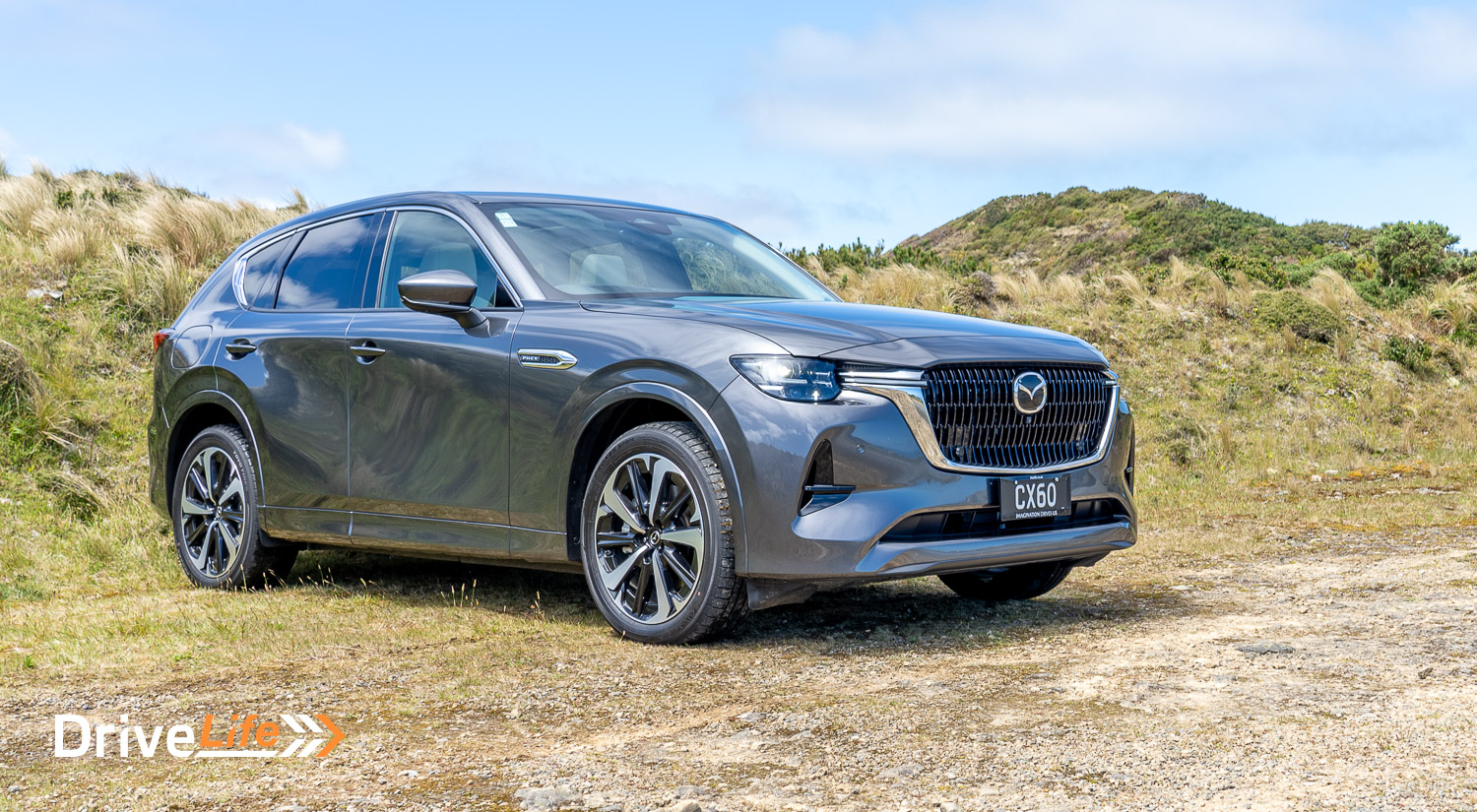
2023 Mazda CX-60 Standard Equipment Highlights
As standard, all models have:
- Auto-dimming rearview mirror
- 8-speaker audio system
- 12.3” infotainment screen
- 12.3” dashboard
- Wireless Apple CarPlay and Android Auto
- Wireless phone charging
- 220-volt/150-watt power outlet in rear
- Heads-up display
- Dual-zone AC
- Paddle shifters
- Leather interior
- 10-way electric driver’s seat
- 8-way electric passenger’s seat
- Blind Spot Monitoring
- Rear Cross Traffic Alert
- Vehicle Exit Warning function
- Adaptive Cruise Control with start/stop
- Driver Attention Alert
- Front Cross Traffic alert
- Hill Descent Control
- Hill Start Assist
- Lane Departure Warning
- Lane Keep Assist
- Keyless entry and start
- Tyre Pressure Monitoring
- 20” alloy wheels
- LED headlights
- LED DRLs
- Electric tailgate
- 360-degree camera
- SatNav
The Homura models add:
- Adaptive LED headlights with auto on/off
- Handsfree tailgate open/close
- Bose 12-speaker audio system
- Heated steering wheel
- Electrically adjustable steering wheel
- Heated rear seat (outer)
- Cruising and traffic Support
The Takami adds:
- Nappa leather interior
- White Maple Wood Console
- Woven Fabric dashboard panel
- Body-coloured mirrors
The CX-60 comes in a range of 7 colours:
- Soul Red Metallic
- Machine Grey Metallic
- Rhodium White Metallic
- Jet Black Mica
- Deep Crystal Blue Metallic
- Sonic Silver Metallic
- Platinum Quartz Metallic
There is a surcharge of $700 (incl GST) for Soul Red Crystal Metallic, Machine Grey Metallic and Rhodium White Metallic.
| Model | Model Description | RRP* |
| CX-60 Touring PHEV | CX-60 e-SKYACTIV PHEV AWD | $78,990 |
| CX-60 Homura Hybrid | CX-60 e-SKYACTIV G 3.3 M Hybrid Boost AWD | $81,990 |
| CX-60 Homura PHEV | CX-60 e-SKYACTIV PHEV AWD | $87,990 |
| CX-60 Takami PHEV | CX-60 e-SKYACTIV PHEV AWD | $90,990 |
Including the Machine Grey paint option, our Takami PHEV test car has a retail price of $91,690.
Our Homura 3.3 had no options, so retails at $81,990.
For a full list of specs and options available for the 2023 Mazda CX-60 head on over to the Mazda New Zealand website.
How Does The 2023 Mazda CX-60 Compare To Its Competition?
We’re sticking to the PHEV model here for comparison since that’s what most buyers are looking for.
Please note DriveLife does its best to ensure the information below is correct at the time of publication, however, prices and models can change over time. Please bear that in mind when comparing models in the comparison table.
All prices below exclude the refund or additional cost of the New Zealand Clean Car Programme.
| Make/ Model | Engine | Power/ Torque kW/Nm | Seats | Fuel L/100km | Towing Capacity | Boot Space, litres | Price (excl CCP) |
| BMW X3 xDrive 30e | 2.0-litre, 4-cylinder turbo-petrol plug-in hybrid | 215/420 | 5 | 3.2 | 750/2,000 | 450 | $115,990 |
| Audi Q5 50 TFSI e | 2.0-litre, turbocharged, 4-cylinder petrol/plug-in hybrid | 220/450 | 5 | 1.6 | 750/2,000 | 465 | $114,990 |
| Lexus NX450h+ F Sport | 2.5-litre, 4-cylinder turbo-petrol plug-in hybrid | 227/227 | 5 | 1.4 | 750/1,500 | 545 | $111,100 |
| Mazda CX-60 Takami PHEV | 2.5-litre, 4-cylinder petrol plug-in hybrid | 241/500 | 5 | 2.1 | 750/2,500 | 570 | $90,990 |
| Kia Sorento Premium PHEV | 1.6-litre, 4-cylinder turbocharged petrol/plug-in hybrid | 193/350 | 7 | 1.6 | 750/1,350 | 608 | $89,990 |
| Hyundai Tucson Elite Plug-in Hybrid | 1.6-litre, turbocharged 4-cylinder petrol plug-in hybrid | 195/350 | 5 | 1.4 | 750/1,350 | 503 | $89,990 |
| Mitsubishi Outlander VRX PHEV | 2.4-litre, 4-cylinder petrol/plugin hybrid | 185/450 | 7 | 1.6 | 750/1,600 | 472 | $79,990 |
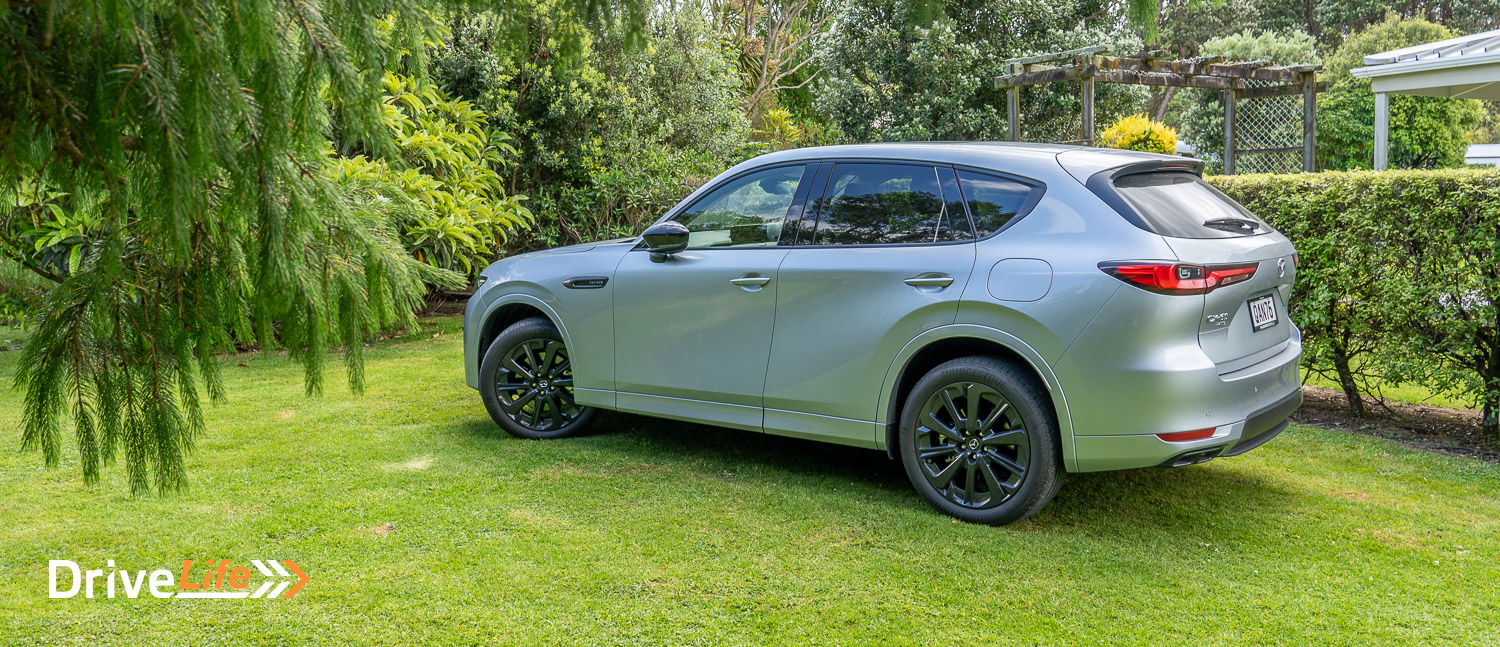
First Impressions Of The 2023 Mazda CX-60 Takami/Homura
A lot of people were wondering where Mazda would go next with its styling; the current-gen CX-5, CX-8, CX-9 and other CX models with Mazda’s Kodo design philosophy look excellent; walk through any car park and a recent Mazda will always stand out from the rest.
The all-new CX-60 and CX-90 have taken that design and kept elements of it, and Mazda seems to have changed the entire look of the car while keeping its family familiarity.
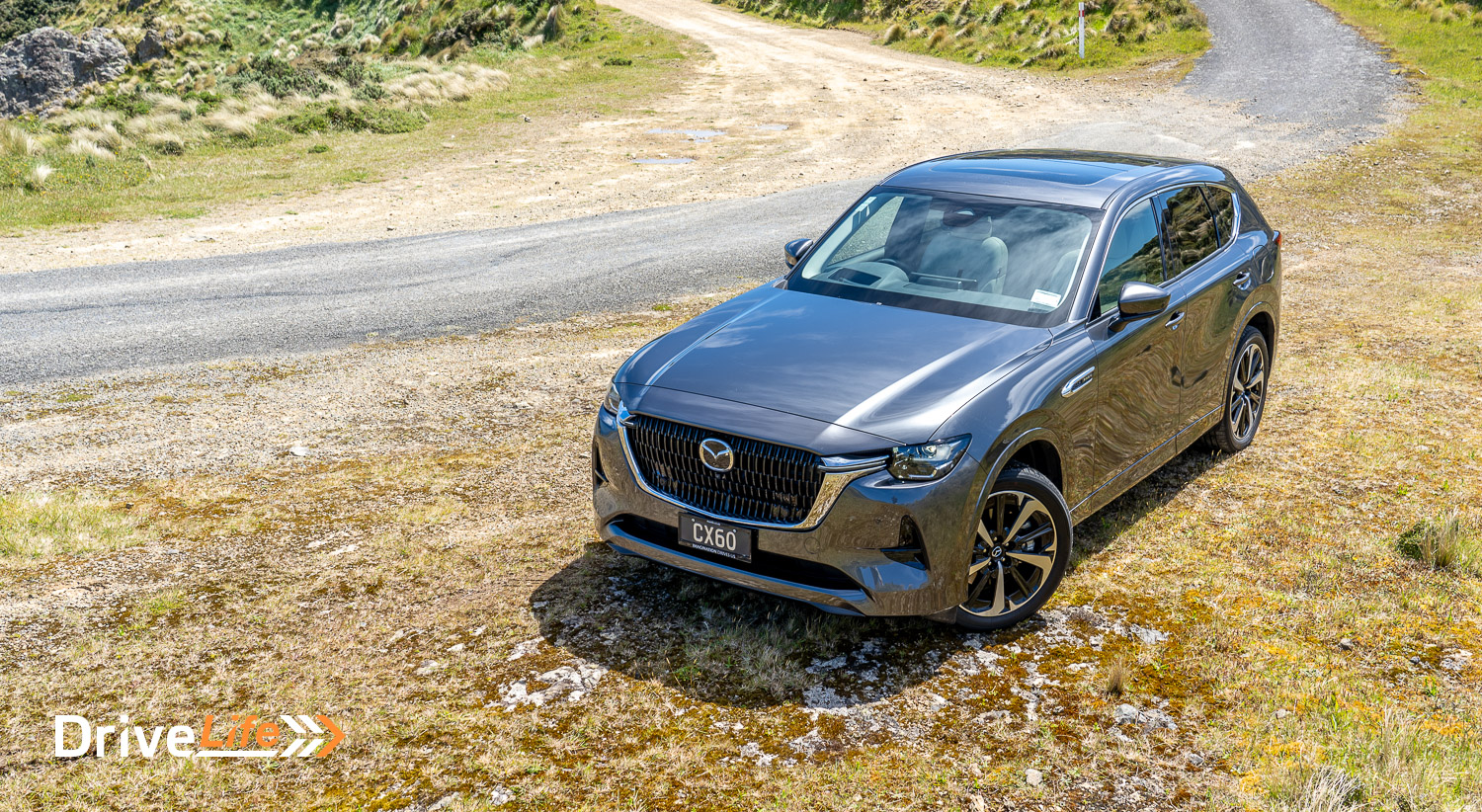
But – does it look good? Yes, even finished in grey, our test Takami still stands out from the hordes with that tall front end and very long bonnet giving the CX-60 a point of difference. And while the Homura may be one spec-level down, there are few changes to make it look too much different. Either model looks fantastic.
Side on, the CX-60 can look a little slab-sided, with a high waistline and deep doors. I feel it needs something to break it up a little, but that’s a personal preference.
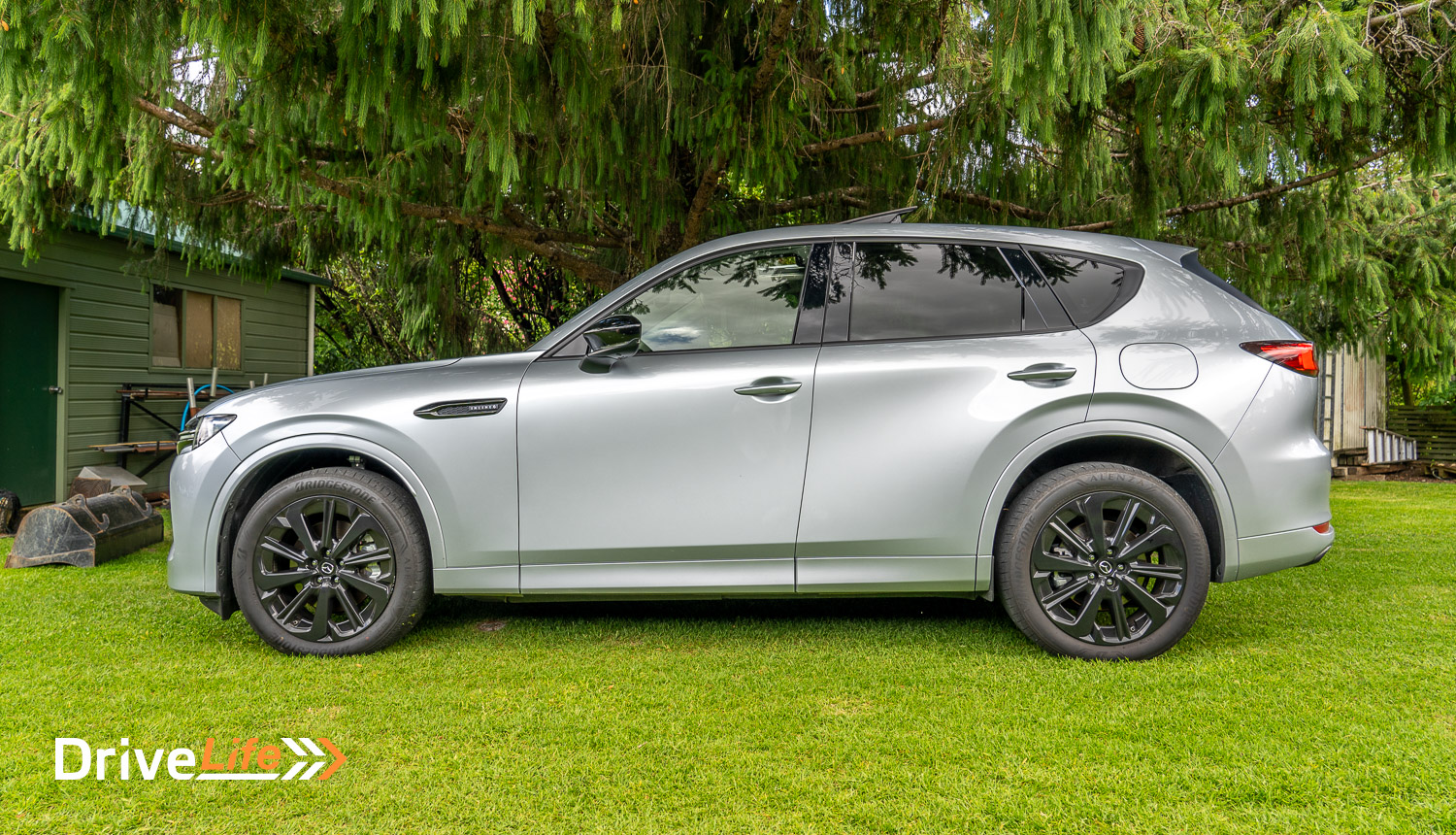
Around the back, sadly Mazda has decided the car needed four fake exhaust tips for both models. The actual exhaust pipes finish just before these and then point down. Hopefully, we won’t see this design feature on future Mazdas. The rear of the car has that all-too-familiar Mazda family look, and yet modernised and stylish. Fake exhaust tips aside, it is uncluttered and exudes a feeling of luxury.
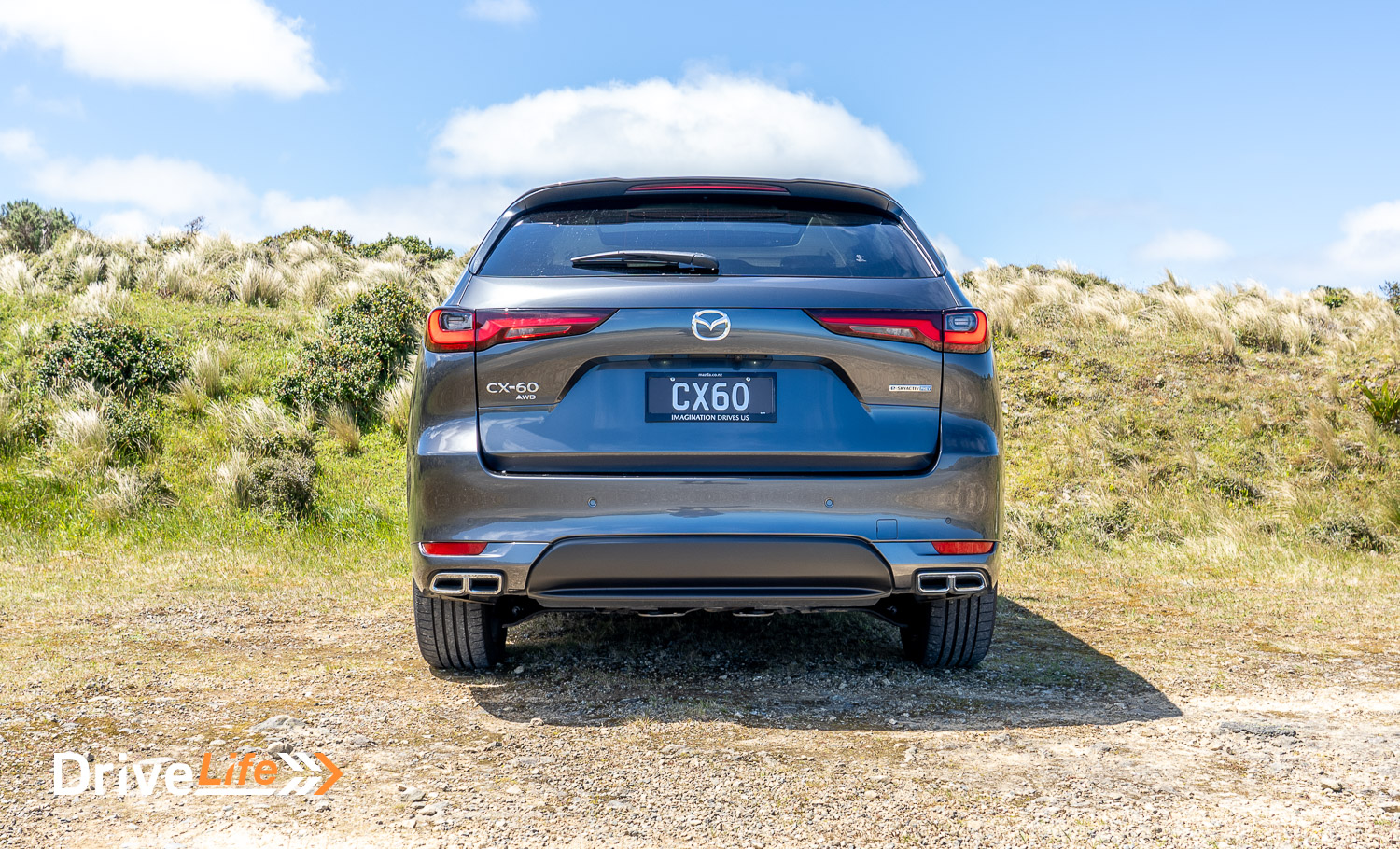
What’s The Interior Like In The 2023 Mazda CX-60?
Opening the door of our CX-60 Takami PHEV test car was a mind-blowing experience; the luxury, choice of materials and colours is nothing less than amazing. Anyone who got in the car oohed and ahhed over this car’s interior. Lexus may be in trouble here – there’s a new player in town for a luxurious interior.
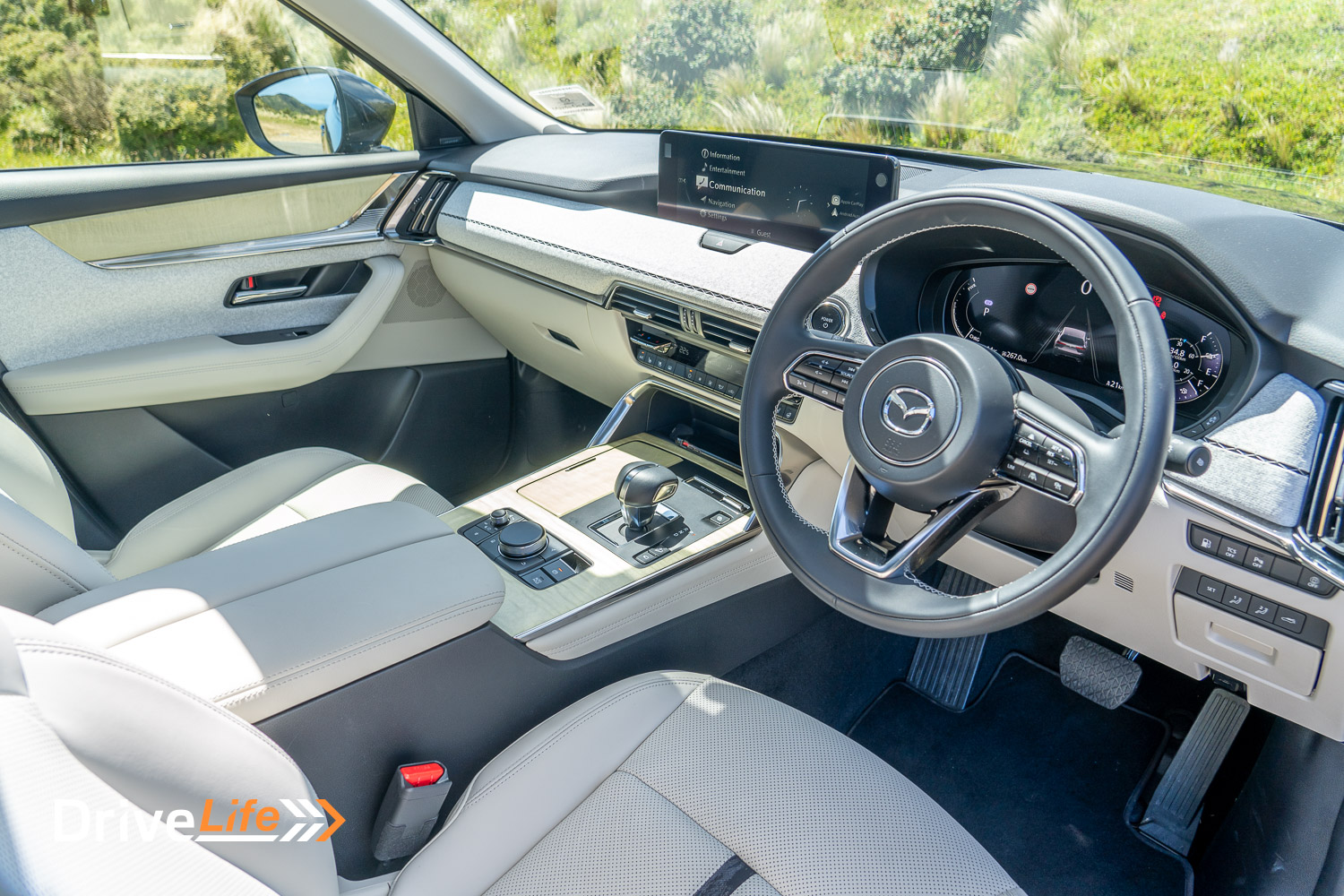
There are padded surfaces everywhere, and while the white padded dash pad might attract dirty fingers, it looks superb and the doors have the same finish over parts of them. It’s one of those things that your fingers instantly go to, to have a feel. The luxury of the interior continues with the fake wood trim across the centre console and doors. In our Takami test car, this was finished in White Maple Wood, but for me, it looked too fake. It may not be popular, but I prefer a woodgrain that actually looks like wood.
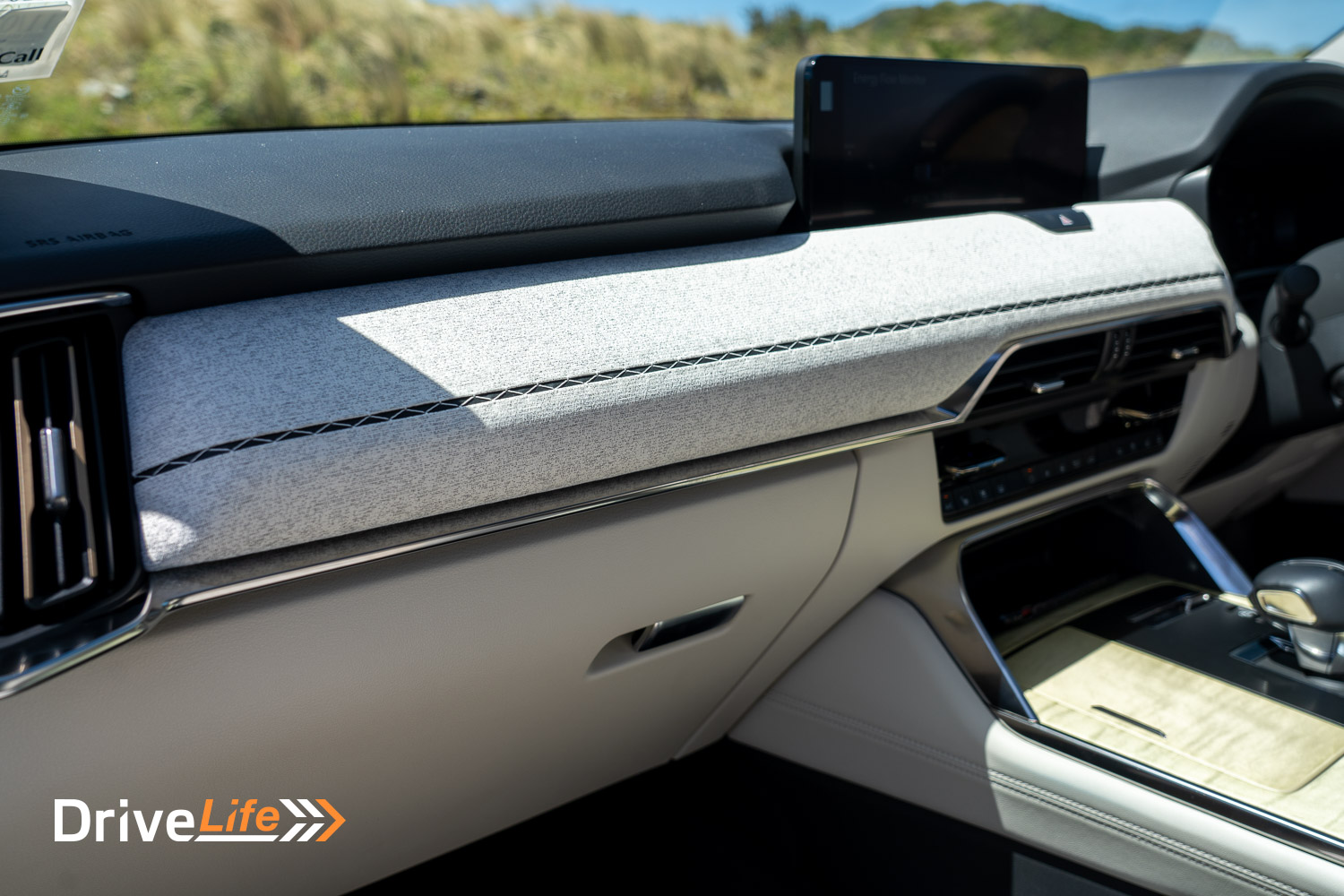
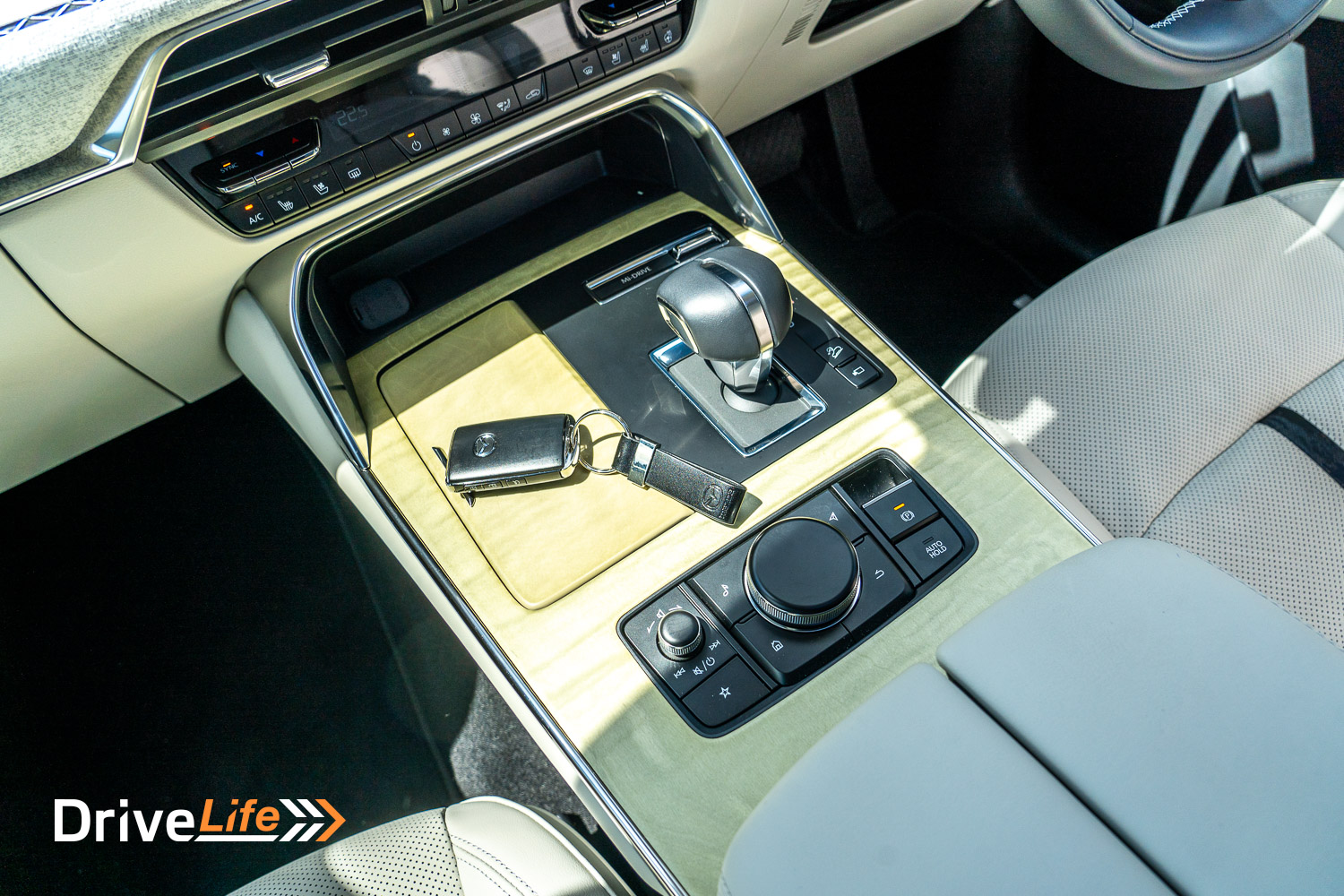
Along with almost white leather seating, there was a white headliner in our Takami test car and that along with the sunroof blind opening up meant a huge amount of natural light inside the CX-60, highlighting its luxurious look and feel. Even the air vents at the ends of the dash have a chrome finish to them.
Being the top-spec Takami, there are plenty of features. All the seats are heated (except the middle rear), the front seats are ventilated, and the steering wheel is heated as well as being electrically adjusted for height/reach. Not a big issue at all, but the steering wheel heater has just one setting. We’re seeing more and more vehicles with 2 or 3 settings for heating the steering wheel. Yes, I know – a first-world problem, but it was hard to fault the equipment levels or the interior of the CX-60, so let me have this one.
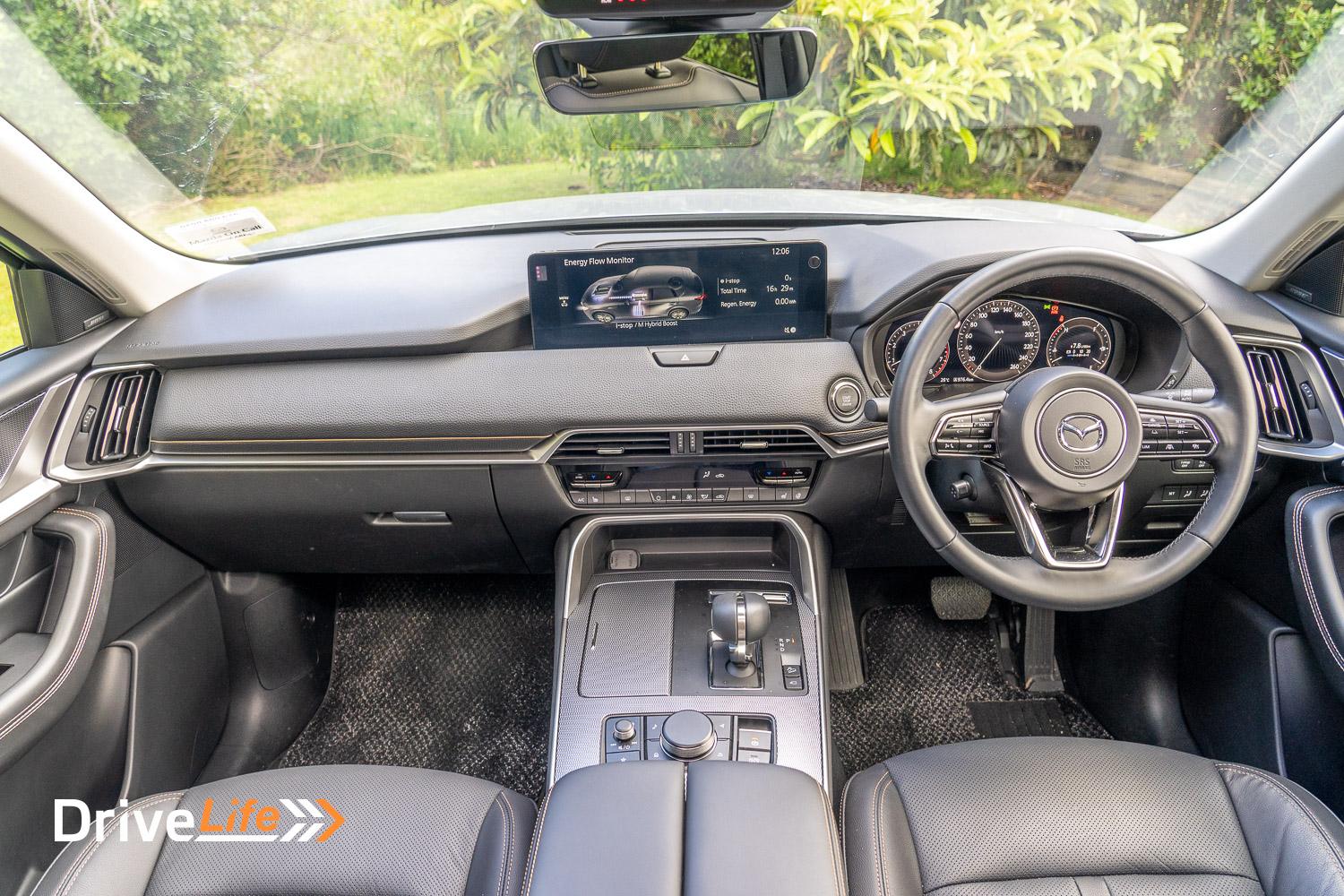
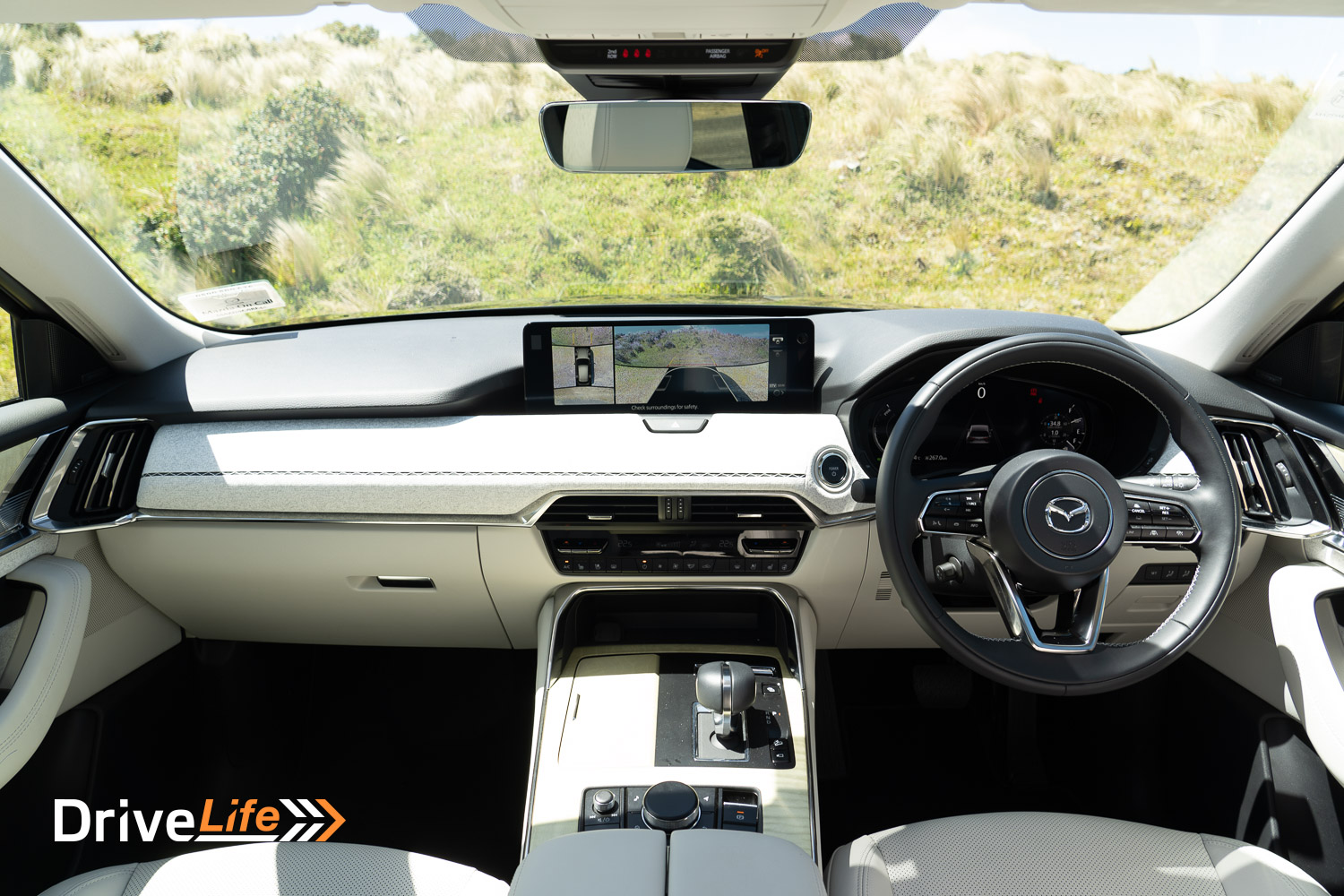
Up top, there is an electric sunroof with an electric blind, and both the Takami and Homura are fitted with a Bose sound system. The CX-60 Takami is extremely well-equipped.
The 3.3-litre model had black seats with gold contrasting stitching on the seats, doors, and console. While this didn’t make the interior as bright as the Takami, the white headliner helped it along. It still has a sunroof like the Takami, but weirdly, while the sunroof glass goes all the way back, the sunroof itself only opens up around 250mm, so perhaps it’s more usable to let hot air out while parked than using it as a ‘normal’ sunroof.
The Homura also has heated front seats, a heads-up display, and an electrically adjustable steering wheel. Other than the ventilated front seats, the Homura model doesn’t want for much, and it would be a tough call to go for the Takami model unless you wanted that 3.3 six, since the Takami only comes with a 4-cylinder and plug-in hybrid drivetrain.
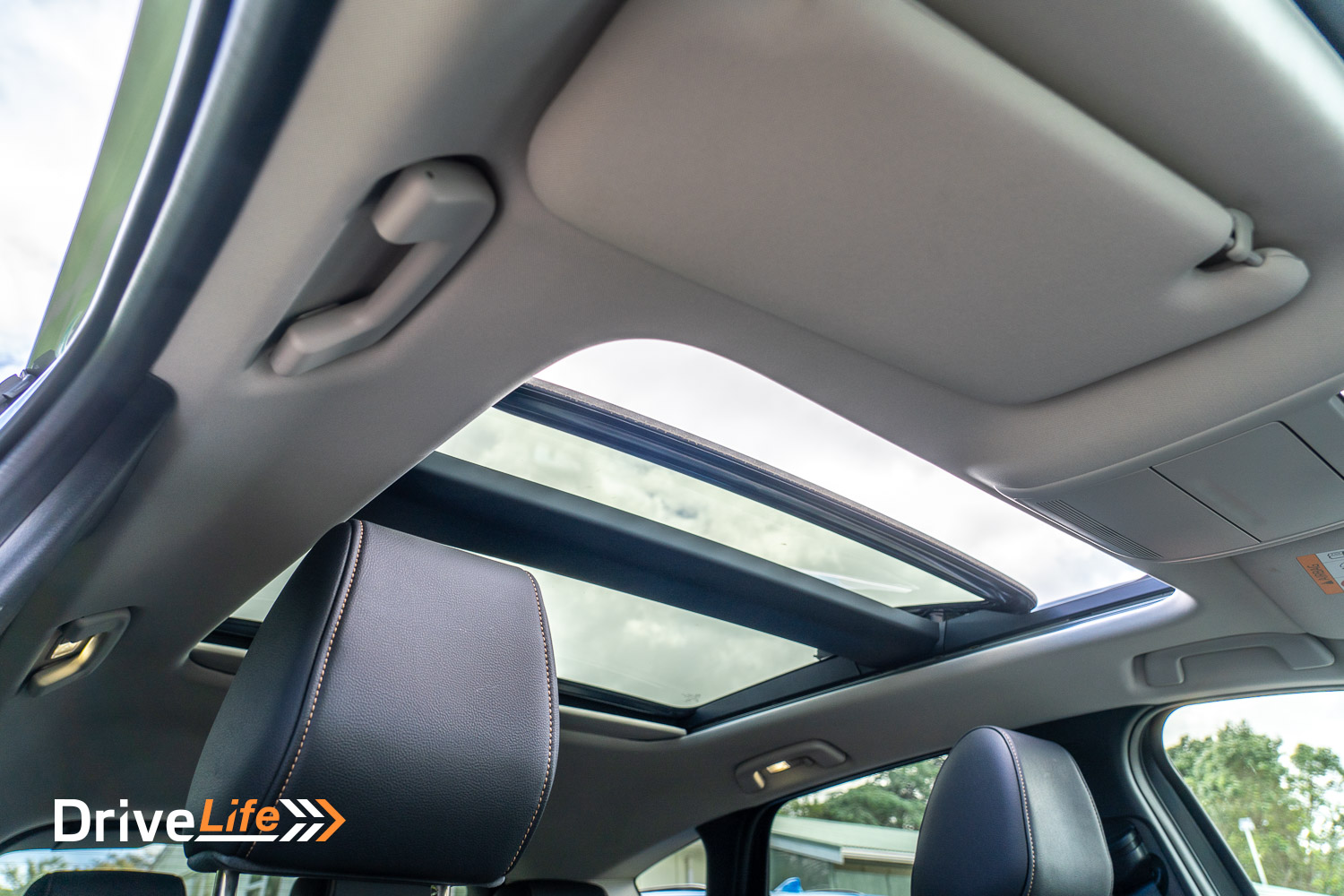
While Mazda did give the CX-60 fake exhaust tips, thankfully they have used physical, hard buttons for all the AC controls. Long may they reign. There is no need to go into any menus to adjust the ventilation system, turn on your seat heat/cooling, or heat the steering wheel. With so many manufacturers moving these controls to the infotainment screen, Mazda proves if it ain’t broke, don’t fix it.
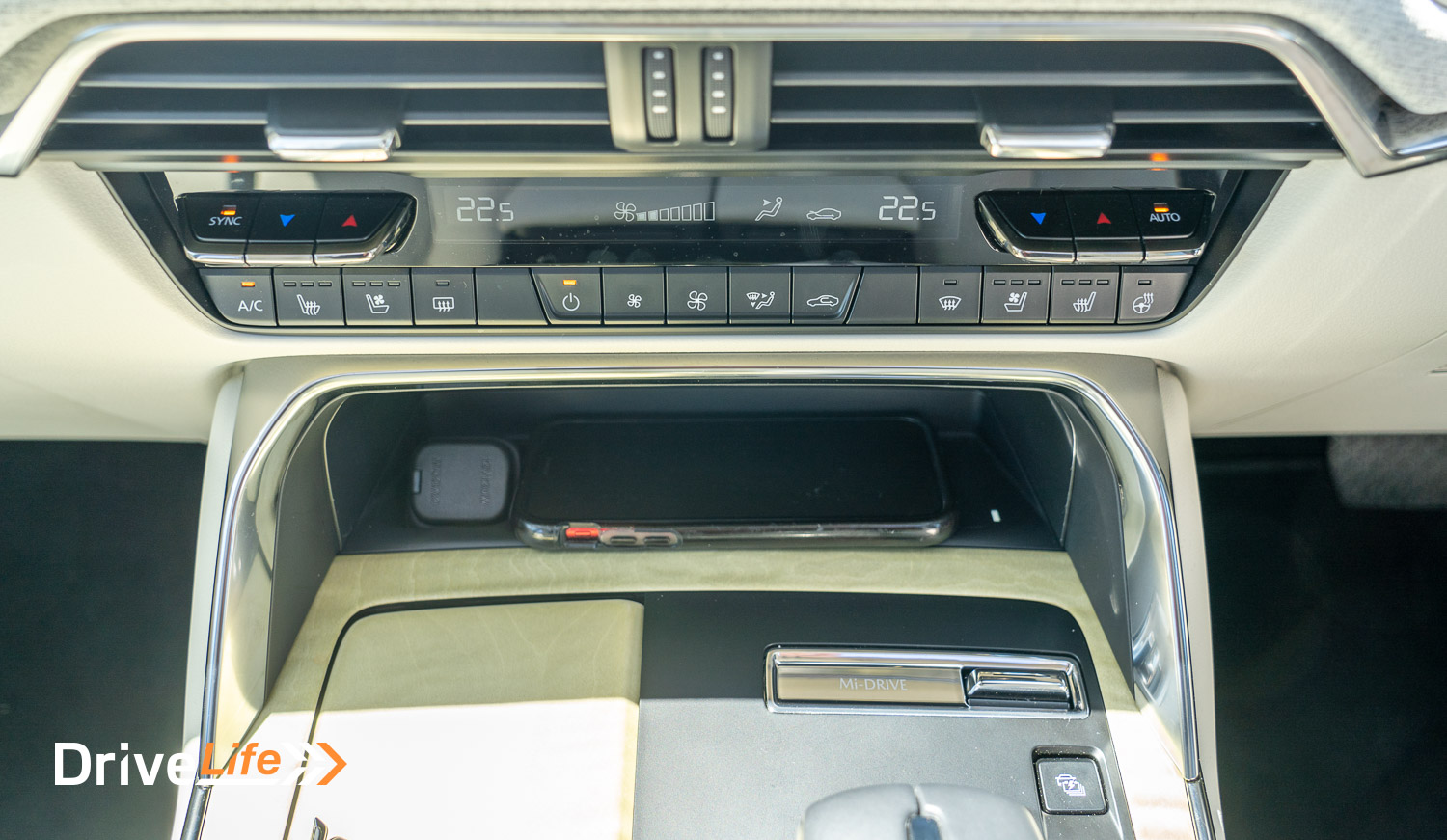
Like the bigger CX-90, the CX-60 also has a very wide centre console that has a large but shallow cubby with two USB-C ports inside. In front of the cubby is Mazda’s standard volume knob; this works brilliantly and I often used it instead of the steering wheel controls. It’s so simple and intuitive, I was happy to see it hasn’t been dumped in the CX-60. At the front of the console, there is a 12-volt socket I used for my dash cam, and to the right of that is a flat but shallow Qi wireless phone charging pad. Your phone actually sits proud of the charging pad since it’s not very deep, but I didn’t have any issues with my phone charging.
Rounding out the storage areas is a medium-large glovebox, and happily, my large drink bottle fitted into the door pockets with no problem. On the right-hand side of the steering wheel is a tiny little cubby behind a door of its own. I think a packet of chewing gum might fit in here, but little else; it seems superfluous.
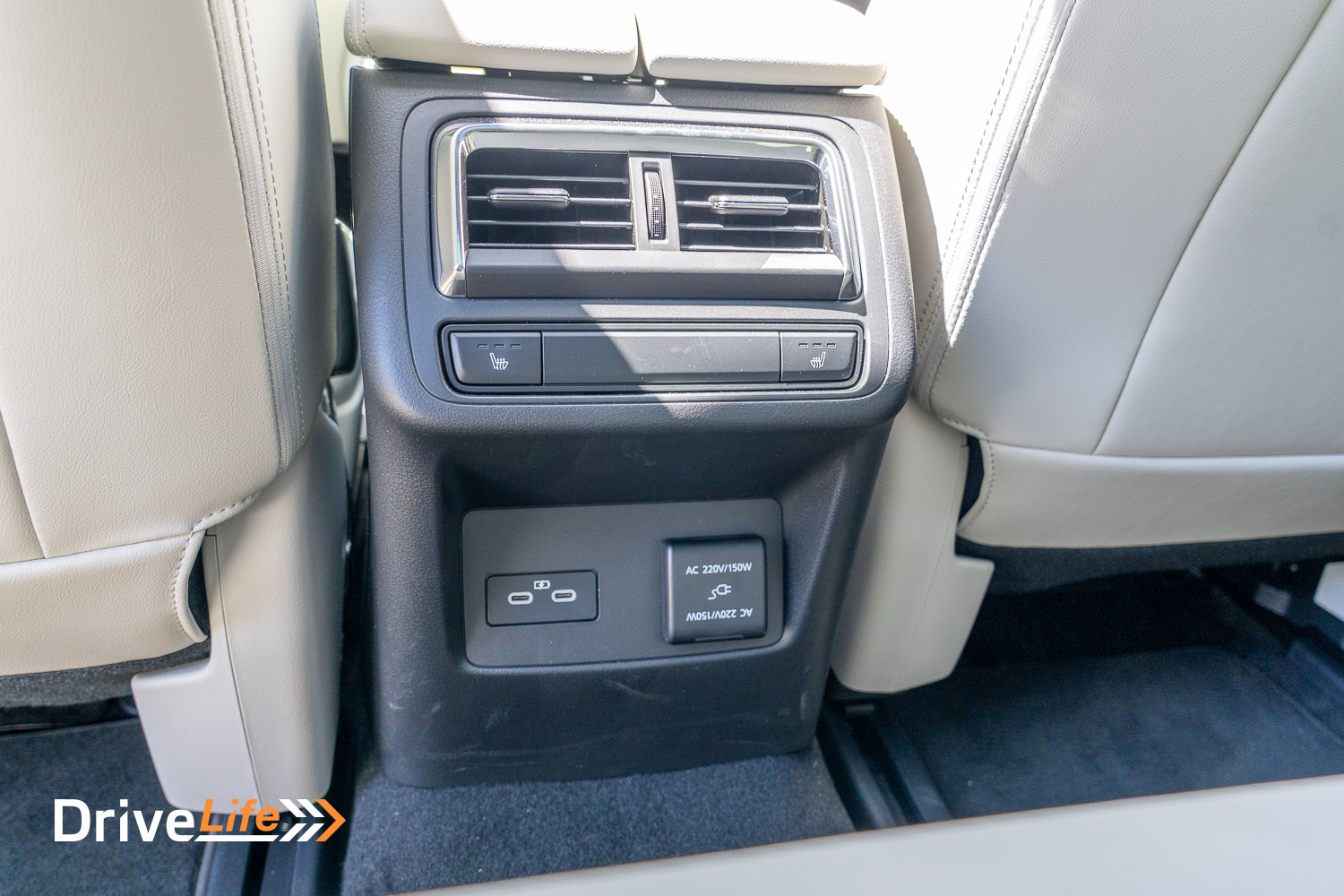
Space-wise, all passengers have width to spare, and in the front there’s plenty of leg and headroom. Rear-seat passengers have less legroom and because of the electric sunroof, less headroom, meaning these two areas are pretty average for the class. But those back-seat passengers do get a 150-watt, 220-volt power outlet for charging devices, along with two USB-C ports. Like the CX-5, the rear doors open out almost perpendicular, meaning easy entry and exit for those who might struggle.
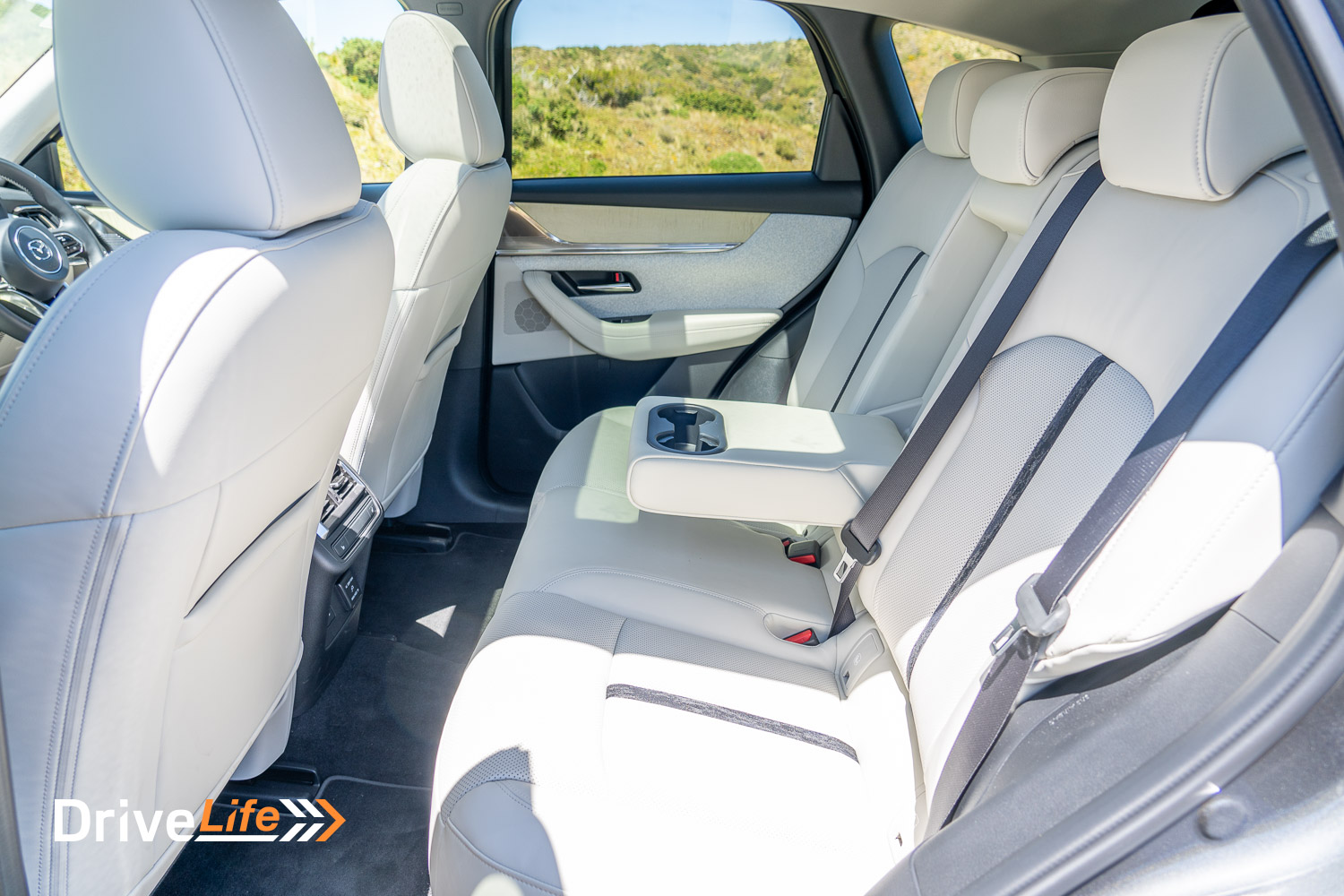
Opening the electric tailgate, the boot is relatively large at 477 litres with the back seats up. Under the floor is a space-saver spare and inside the centre of that is a huge Bose bass speaker. Both models have an electric tailgate.
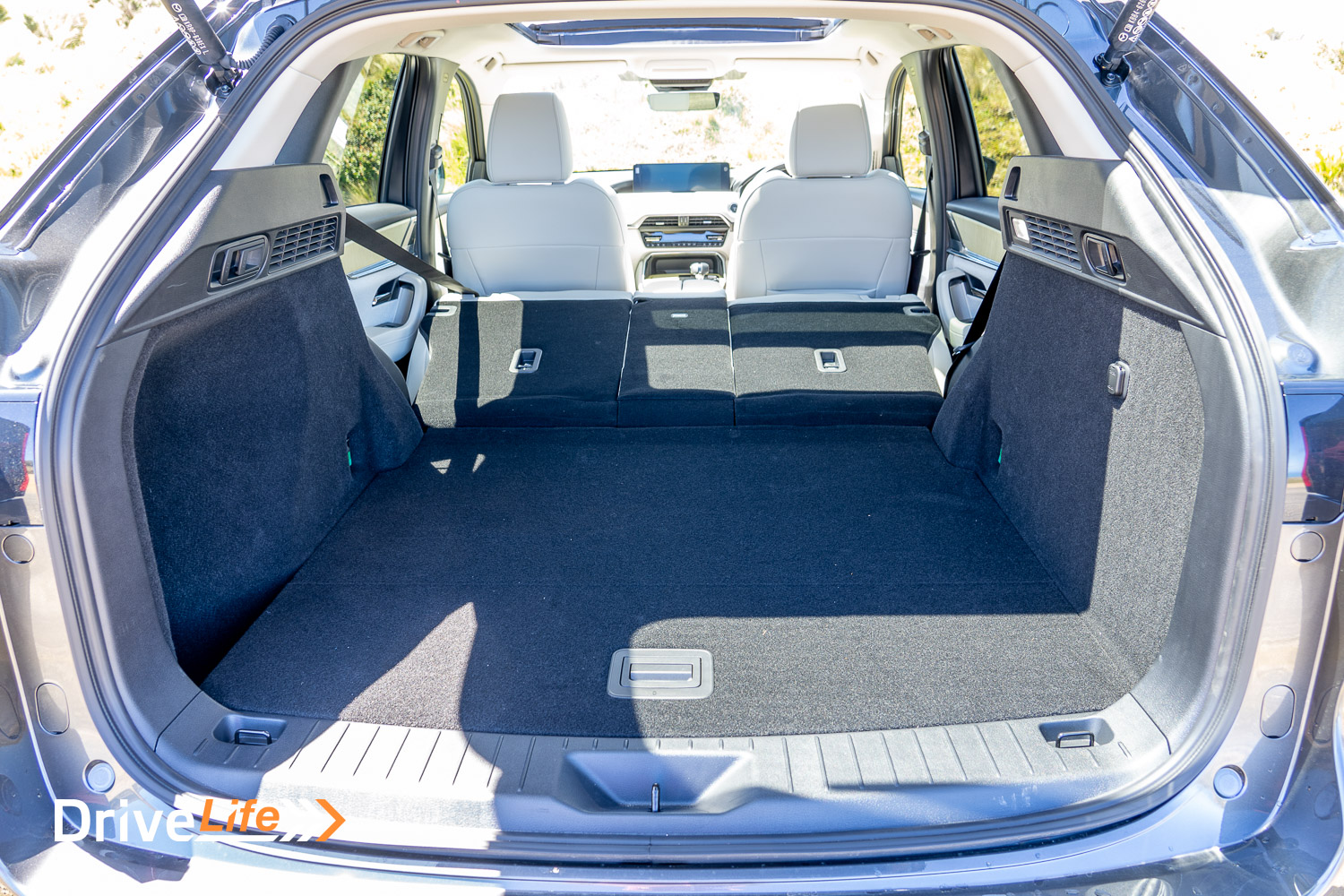
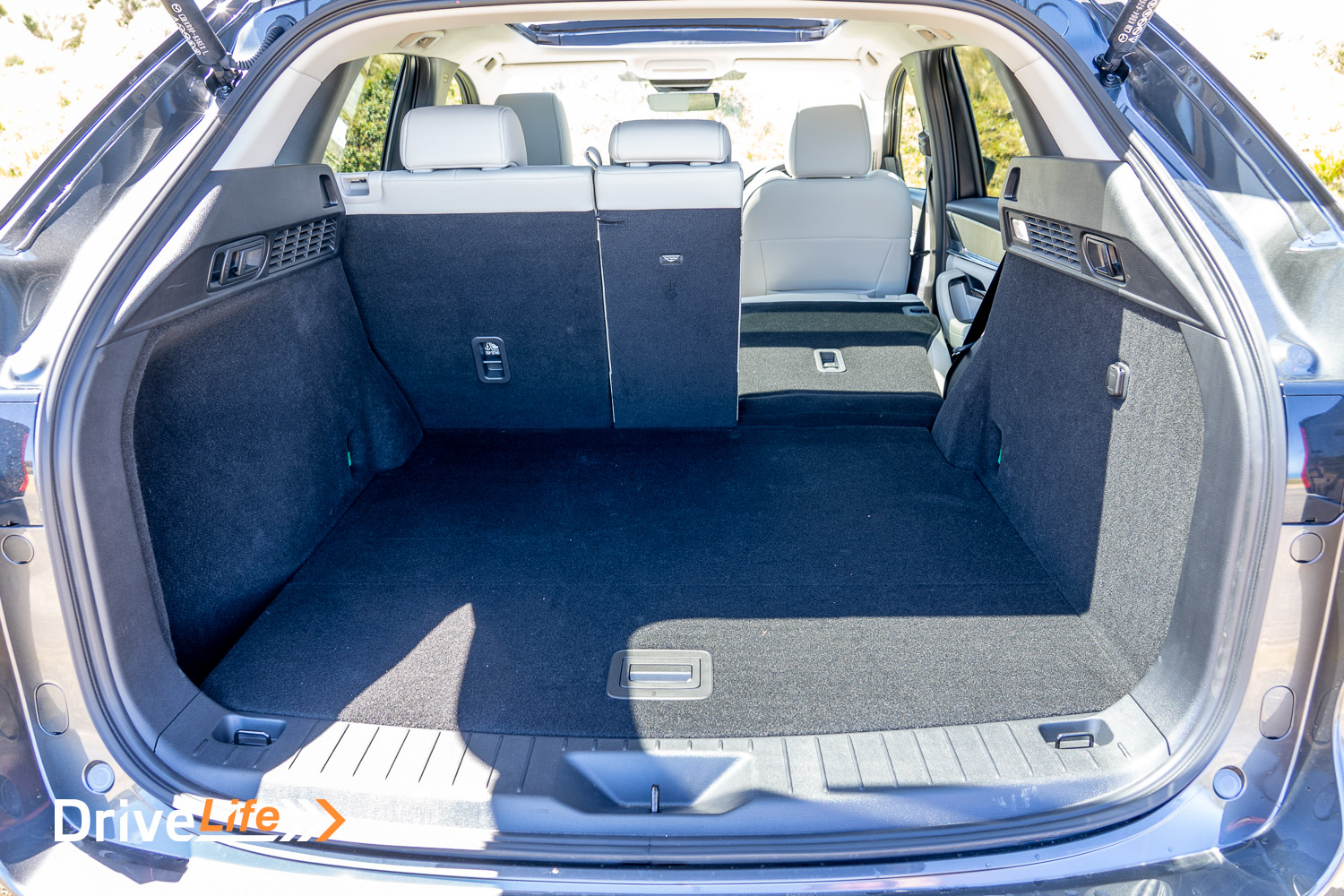
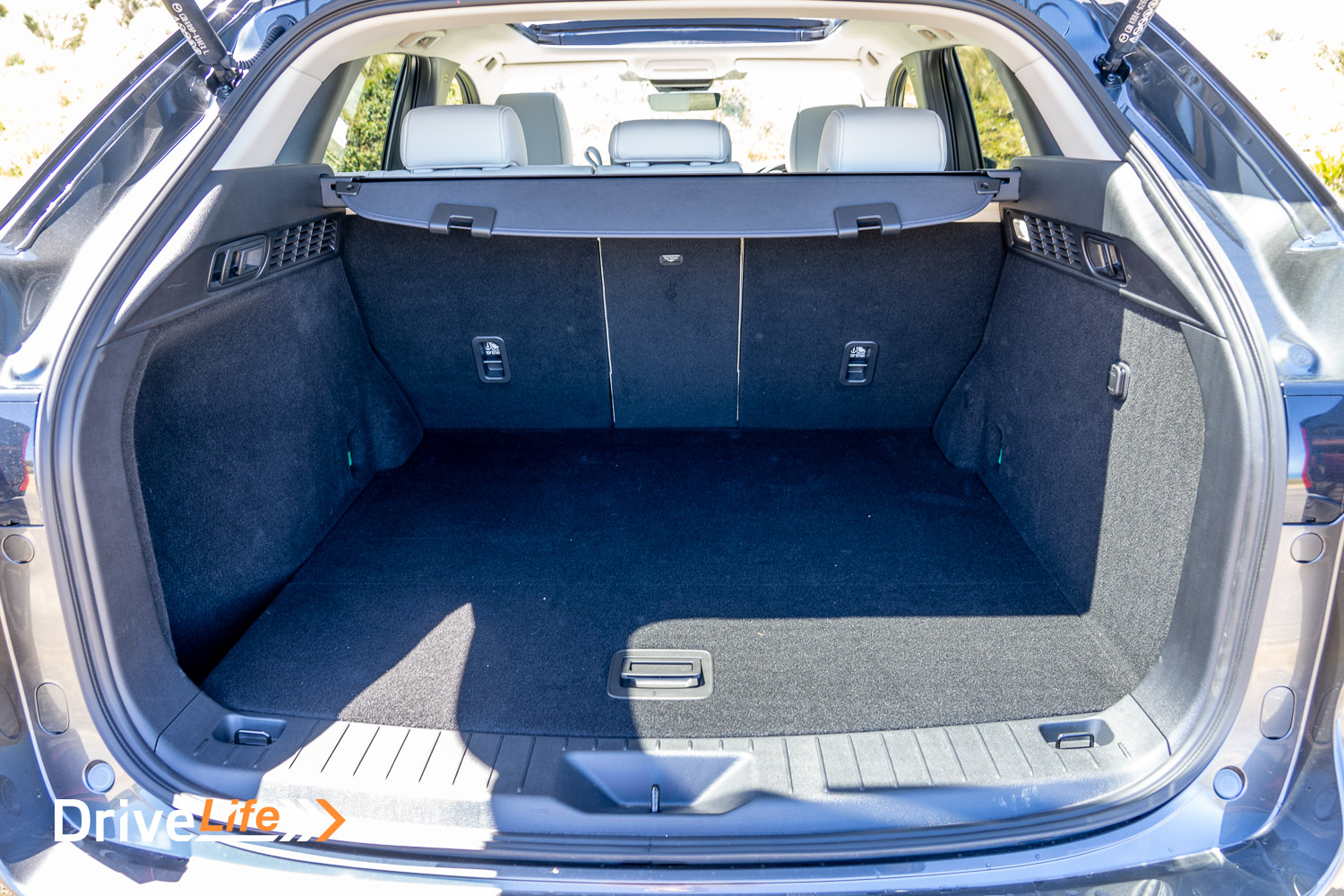
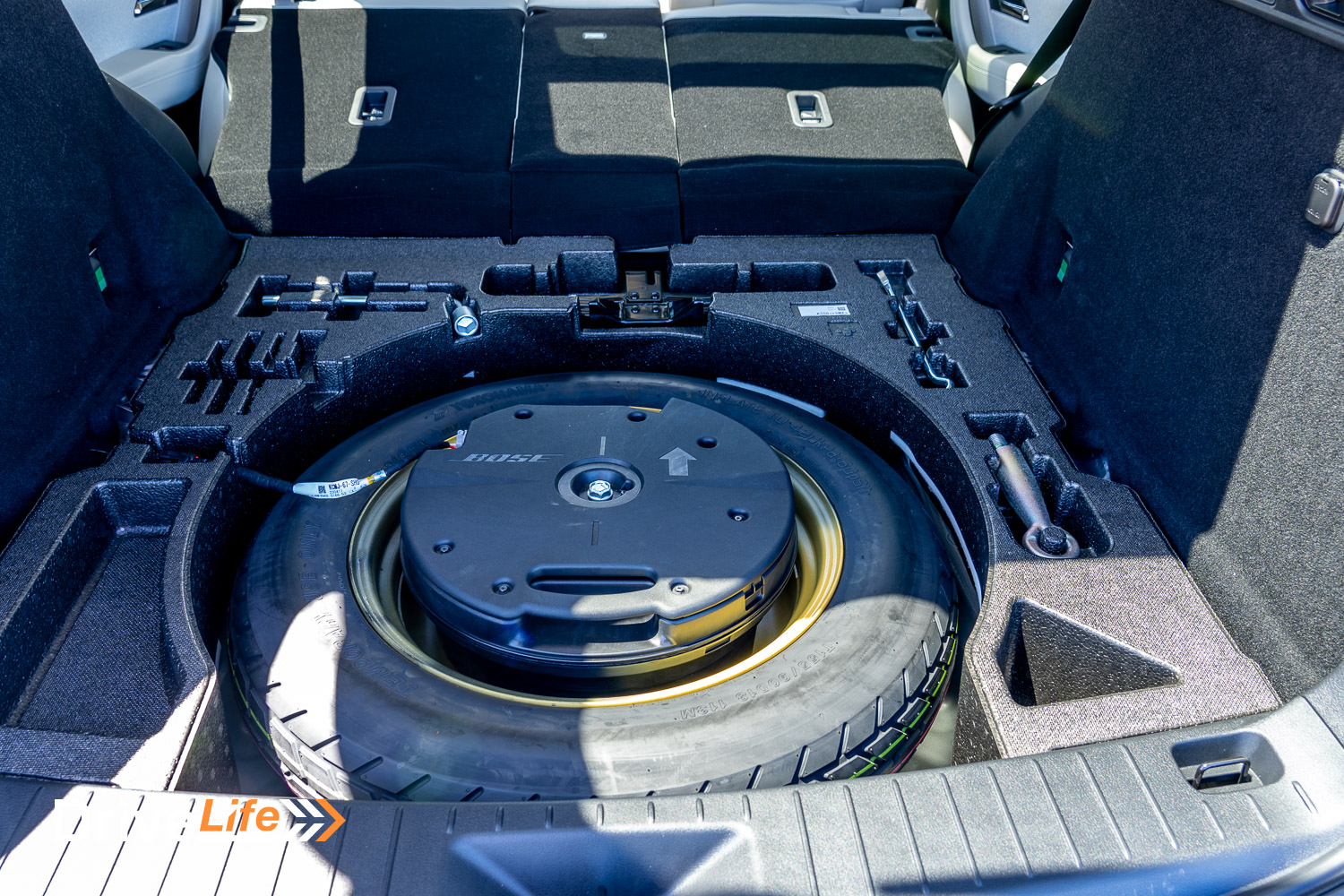
What’s The 2023 Mazda CX-60 Like To Drive?
Picking up the Takami PHEV first, with a fully charged drive battery the range was showing as 54km – enough for most people’s daily driving.
Mazda has taken an approach similar to Skoda’s with their Superb PHEV; they have put the electric motor in between the engine and transmission. This means that while driving on battery, the car will actually change gears. It’s quite a weird feeling, but you get used to it. Driving down hills will see the transmission change down in EV mode, and I found that more weird. But that side of things just worked, and that’s what it’s all about. The powertrain is the 2.5-litre, four-cylinder petrol motor from the CX-5, connected to a 17.8kWh battery pack.

In our original test Skoda Superb, I found some shunting while driving at times, as it felt like the high and instant torque of the electric motor was too much for the transmission. While driving in EV mode in the CX-60 didn’t produce the same shunting, however there was shunting when the car switched from EV to petrol mode, or back. For Mazda, a brand we have come to almost define a smooth drive, this was a bit of a shock. The shunting isn’t terrible, but it seems very out of character, especially when the rest of the car is so totally refined.
So the CX-60 PHEV is quick but not so refined – what about the 3.3-litre model? It is much better, and the smoothness of that straight-six engine can’t be beaten. It does also have some shunting, but mainly that’s when you almost come to a stop at say a Give Way sign, and the engine shuts down and quickly starts again when you hit the gas pedal. Nowhere near as bad as the PHEV, but definitely not as smooth as expected.
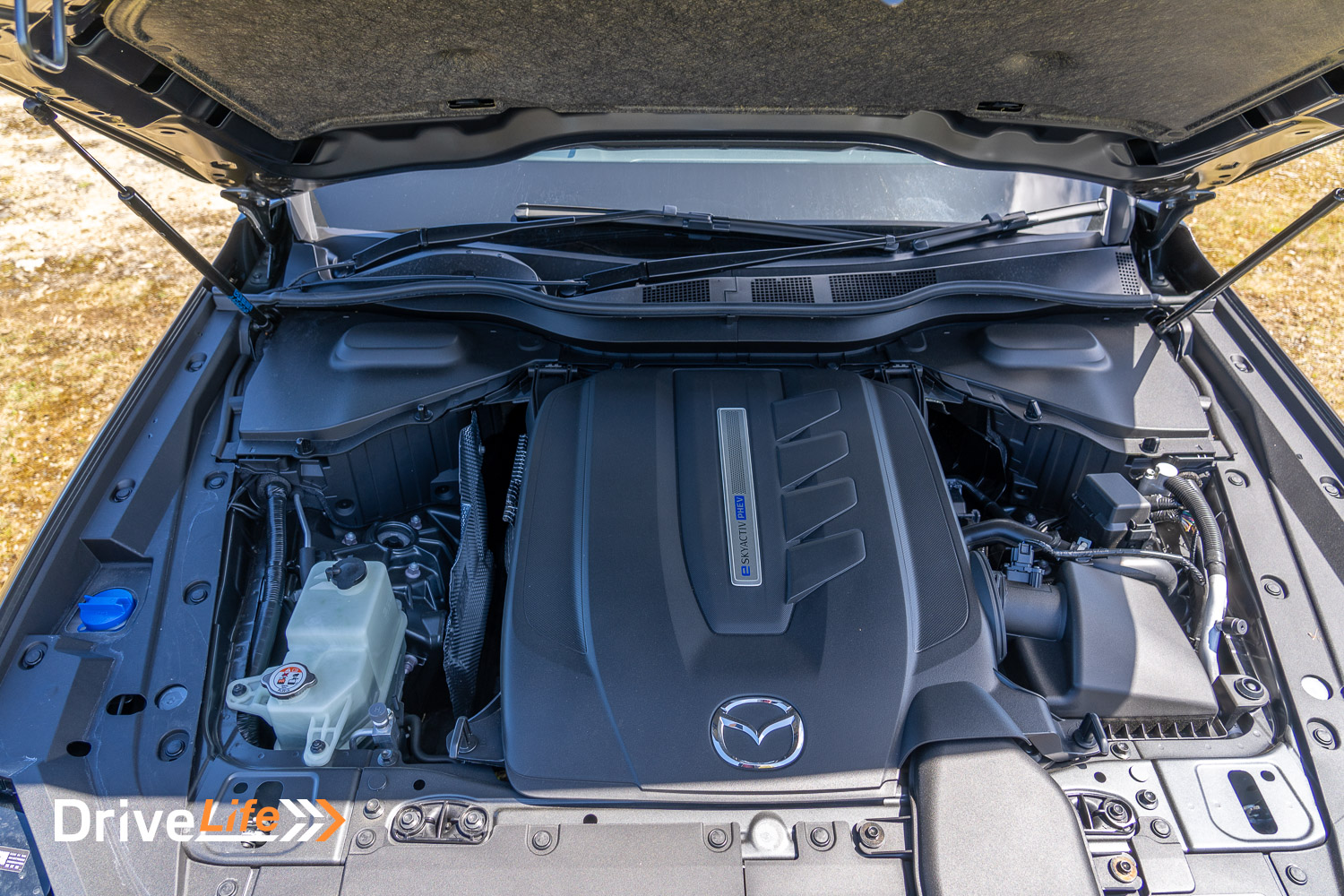
But you can almost forgive the 3.3-litre model for that light shunting when the engine sounds so good. Mazda says that neither the PHEV nor the 3.3 have any fake engine noises, and that means all you are hearing are natural sounds. But Mazda does pipe the induction noise into the cabin to give it a bit more volume. Don’t panic, it’s not overpowering but it is delicious – especially the 3.3-litre model.
That shunting was the worst aspect of the CX-60 and I’m happy to report that most other things were very good, if not excellent. For example, the heads-up display (HUD) is crystal clear and delivers only the information you want to see on the windscreen. On most plug-in hybrids I’ve tested, only a few actually have an arrow on the dashboard to show you which side of the car to use for charging or fueling up. The CX-60 does have an arrow for both, and it did make my life easier. Such a small but (to me) important detail.
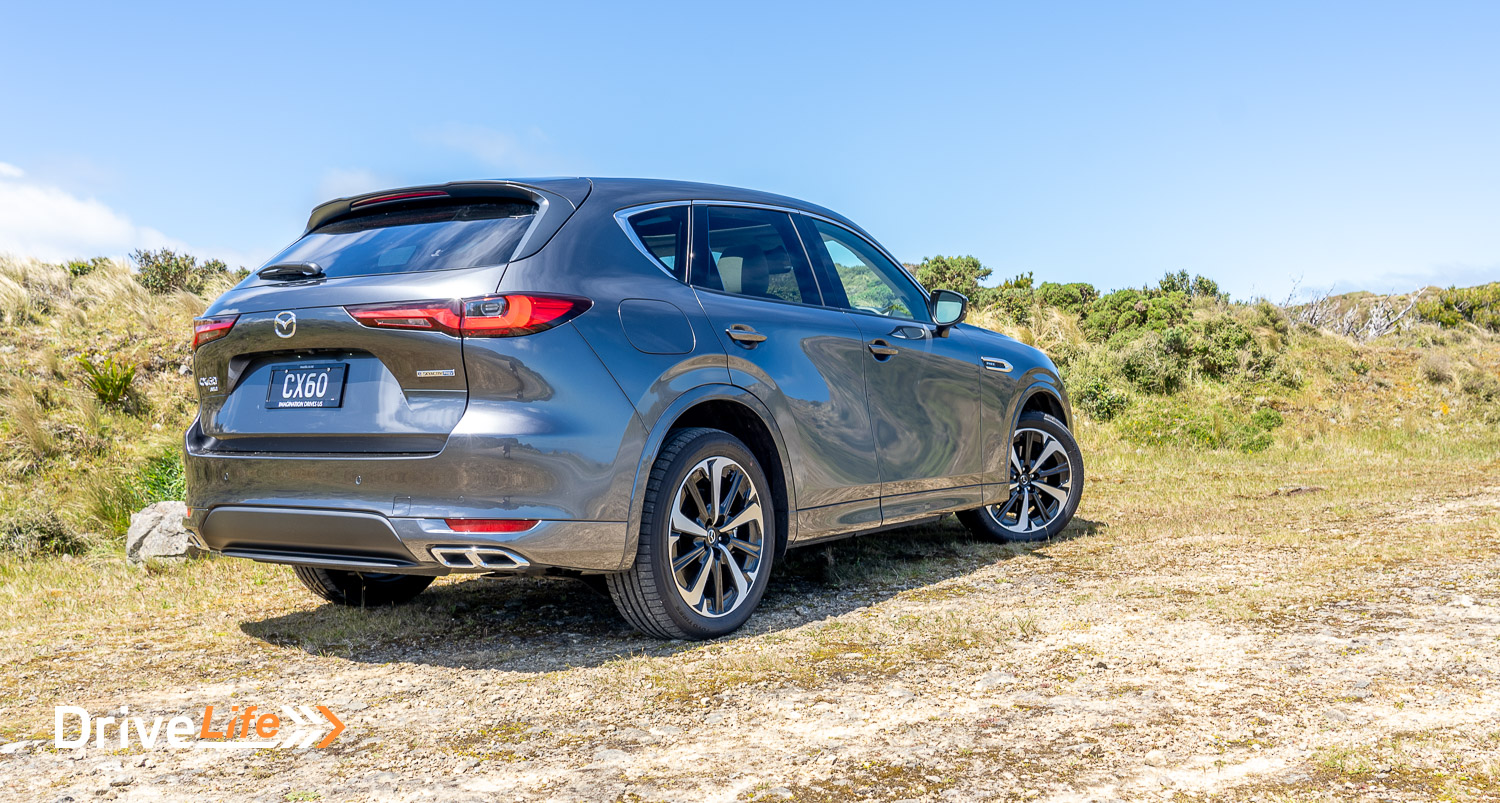
The Takami’s adaptive LED headlights are excellent, with a broad beam of light. If there was one niggle here, it would be that they were a bit slow to respond sometimes – not moving to high beam quickly enough – but that’s better than going to high beam too early I guess.
Not only do the seats in the Takami look luxurious, but they also feel excellent, A little firm, but still good. With a good range of seat adjustments and an electrically adjustable steering wheel, I managed to get my perfect driving position sorted out quickly. It was great to see that the Homura model also has an electrically adjustable steering wheel. Sure, this isn’t essential equipment, but it’s a nice-to-have.
I mentioned in the launch article, that Mazda has stuck with the jog dial for this all-new model – so not a touch screen. I had to stop myself a number of times from touching the screen, as my hand naturally gravitated towards it, but I am sure over time, a CX-60 owner would get used to this. The jog dial works okay, but in 2023 it’s starting to feel a little dated. I found that when using Apple CarPlay, the dial took a lot of spins to get to the desired app or setting. This would be so much faster with a touch screen. Post this review, Mazda says that there is actually some limited touchscreen functionality when using Apple CarPlay, but it’s not well documented. I didn’t find this but to be honest, didn’t really try as it isn’t a touchscreen when not in CarPlay – so assumed it wasn’t at all. I’d be interested to hear owner’s views on this.
At least the infotainment system is quick, there is almost zero lag between screens, as it should be. The infotainment between the two models tested was identical.
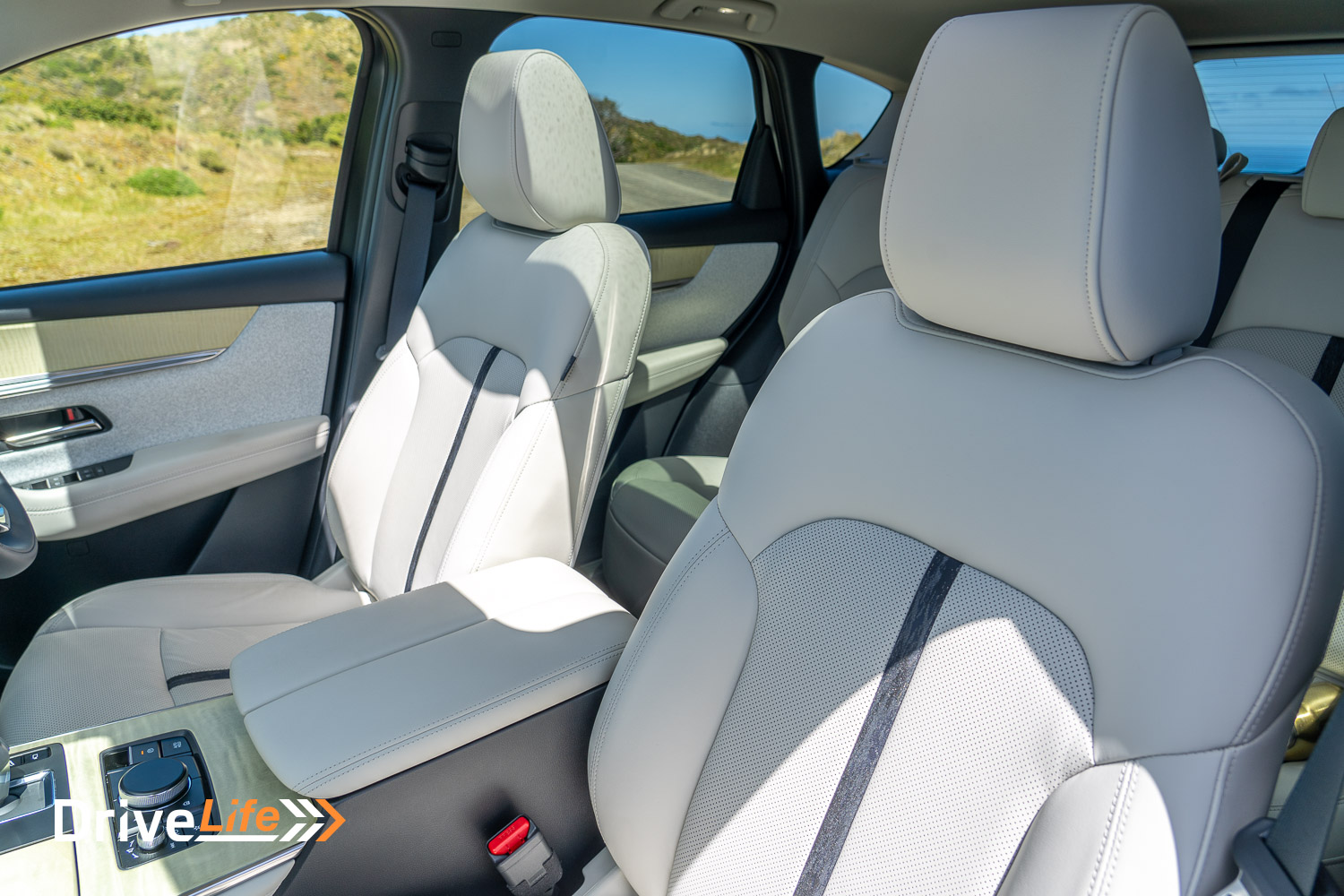
The PHEV model of CX-60 has some brake regeneration (regen) options, but you’ll need to go into the menu system if you want to change these; the steering-wheel paddles change gears only. Even on the strongest setting, regen is pretty light meaning a loss of ‘free’ charge going back into the drive batteries. Not a major, but other brands do regen better than the CX-60.
We’re starting to see just about every test car come out with some sort of system of monitoring the driver, to make sure they are not distracted. The CX-60 is no exception, but like other brand’s systems, it’s a little too eager to call you out. Just looking down at the dashboard can get you a warning, although on the whole, it’s not too bad compared to others. It would be nice to have some adjustments here to be able to tone it down.
While that’s a current downside to the system, having facial recognition can have its benefits. For the CX-60, that means the car will recognise the driver, and adjust the settings for the mirrors, seat, steering wheel etc. It will also adjust the air conditioning, audio and in fact, up to 200 settings can be saved against a ‘face’.
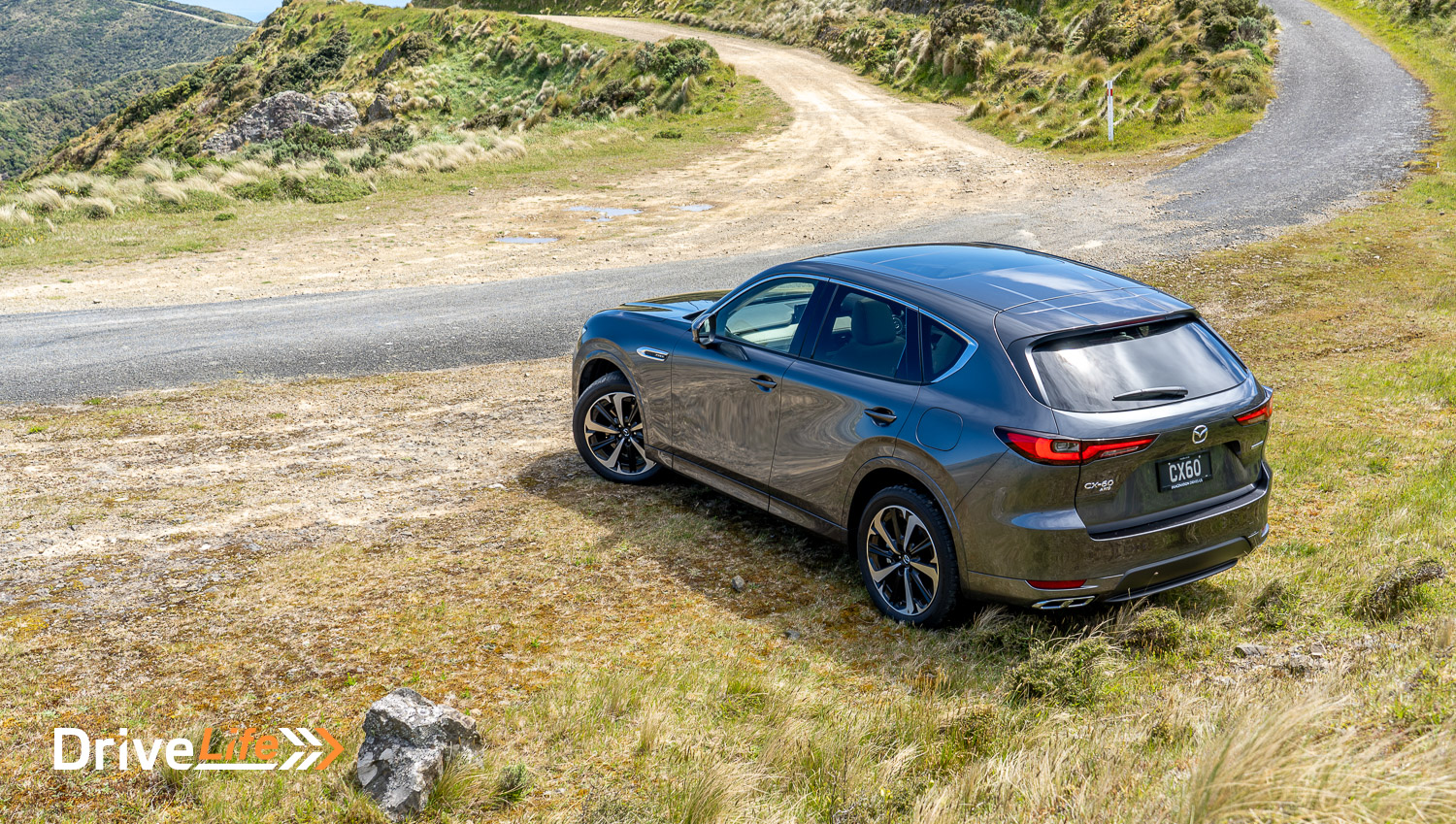
On PHEV models you get to pick from 4 drive modes:
- EV
- Normal
- Sport
- Offroad
The 3.3-litre model drops the EV mode but the others are the same.
For each mode, Mazda says:
Normal Mode
Normal mode pursues the best balance between fuel efficiency and driving performance while providing a comfortable ride in all aspects of daily use.
Sport Mode
Sport mode maximises the potential of the car’s dynamic performance and enhances the responsiveness of the powertrain to support aggressive driving. It also leverages AWD functionality to improve manoeuvring stability and provide a powerful and reassuring driving experience.
Off-road Mode
When driving on dirt roads or deep snow, AWD and the Traction Control System (TCS) shift to deliver traction-oriented characteristics to better handle the challenging conditions. This mode also offers an “off-road traction assist” function to help the driver free their vehicle if it ever gets stuck. Off-road mode allows the driver to go wherever they want without worry.
Towing Mode
When a towing hitch is installed to pull a trailer, the powertrain output characteristics are optimised for the increased weight to provide a satisfying ride. In addition, the AWD is optimised for trailer towing conditions to improve straight-line stability and make long-distance driving more comfortable.
EV Mode (only for PHEV models)
EV mode makes it possible to drive in situations where consideration for the environment or quietness is the priority. For example, it is useful when driving through areas where internal combustion engine vehicles are banned, or when driving in a quiet residential area.
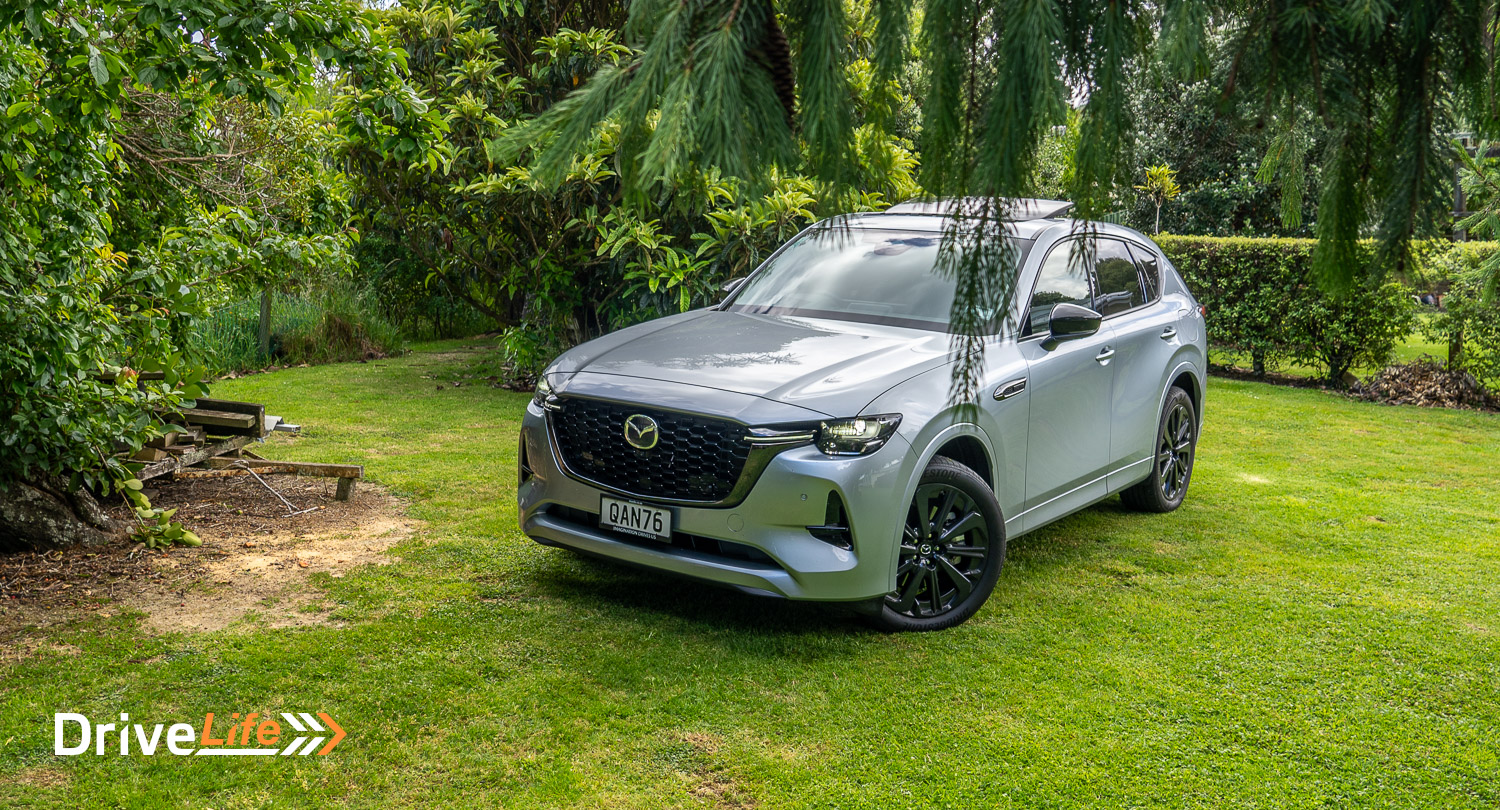
If you are only going to be driving a short distance for the day, then switching the car to EV mode will be what most owners do; really, it’s why they bought the PHEV model in the first place. I did this for most of my time with the PHEV, as I knew that even though for the whole day, I’d be travelling more than the 50km or so max range in EV mode, there would be charging facilities halfway through my day. It was for this reason that the CX-60 PHEV used just 1.0L/100km of petrol. That’s extremely impressive and the first time I’ve achieved a result like that in a PHEV. Mazda suggests the car will use 2.1L/100km, so I managed to beat that number.
The CX-60 PHEV will always reset to Normal drive mode when you restart the car.
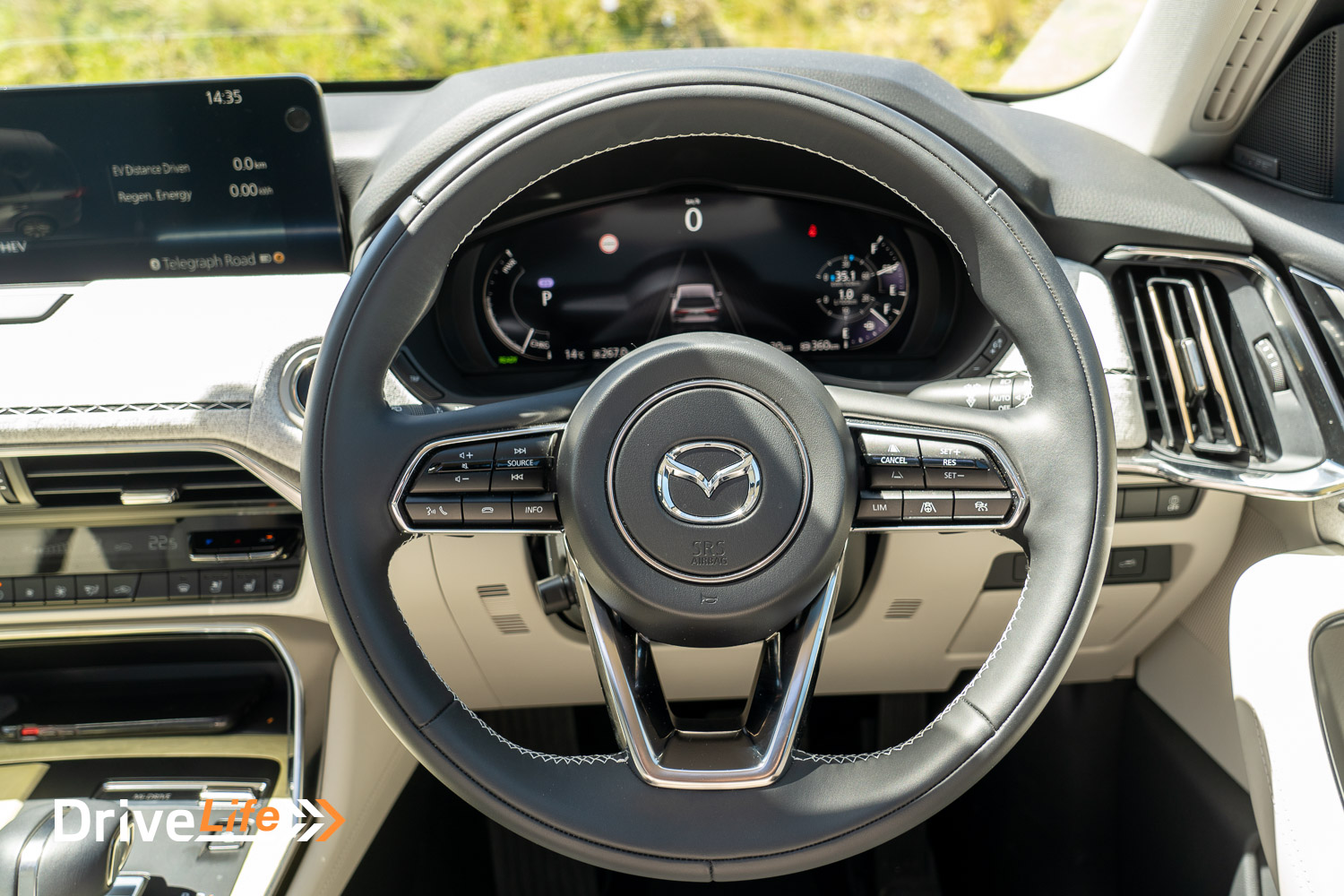
Switching the PHEV to Sport mode will surprise you – this car can really move, getting to 100km/h in 5.8 seconds. That’s an impressive number when you consider the PHEV weighs in at over 2,100kg. The PHEV model feels like it’s running out of puff a bit in the upper rev ranges, but the low-down torque of this SUV is excellent, making it excellent for around-town running.
Taking the Homura 3.3 to Hawera to work on our project car was a great way to spend a decent amount of time behind the wheel of the CX-60. On leaving Wellington, my fuel economy was sitting on 9.7L/100km, which I felt was pretty reasonable for a big, heavy, six-cylinder turbocharged petrol SUV. This car weighs in at over 2,100kg so 9.7 was very respectable.
Using adaptive cruise on the open road shows Mazda’s system to be very smooth and reliable, as was the self-steering feature; the CX-60 followed the road perfectly. When changing lanes, the self-steering was quick to pick up those changes and kick in again quickly.
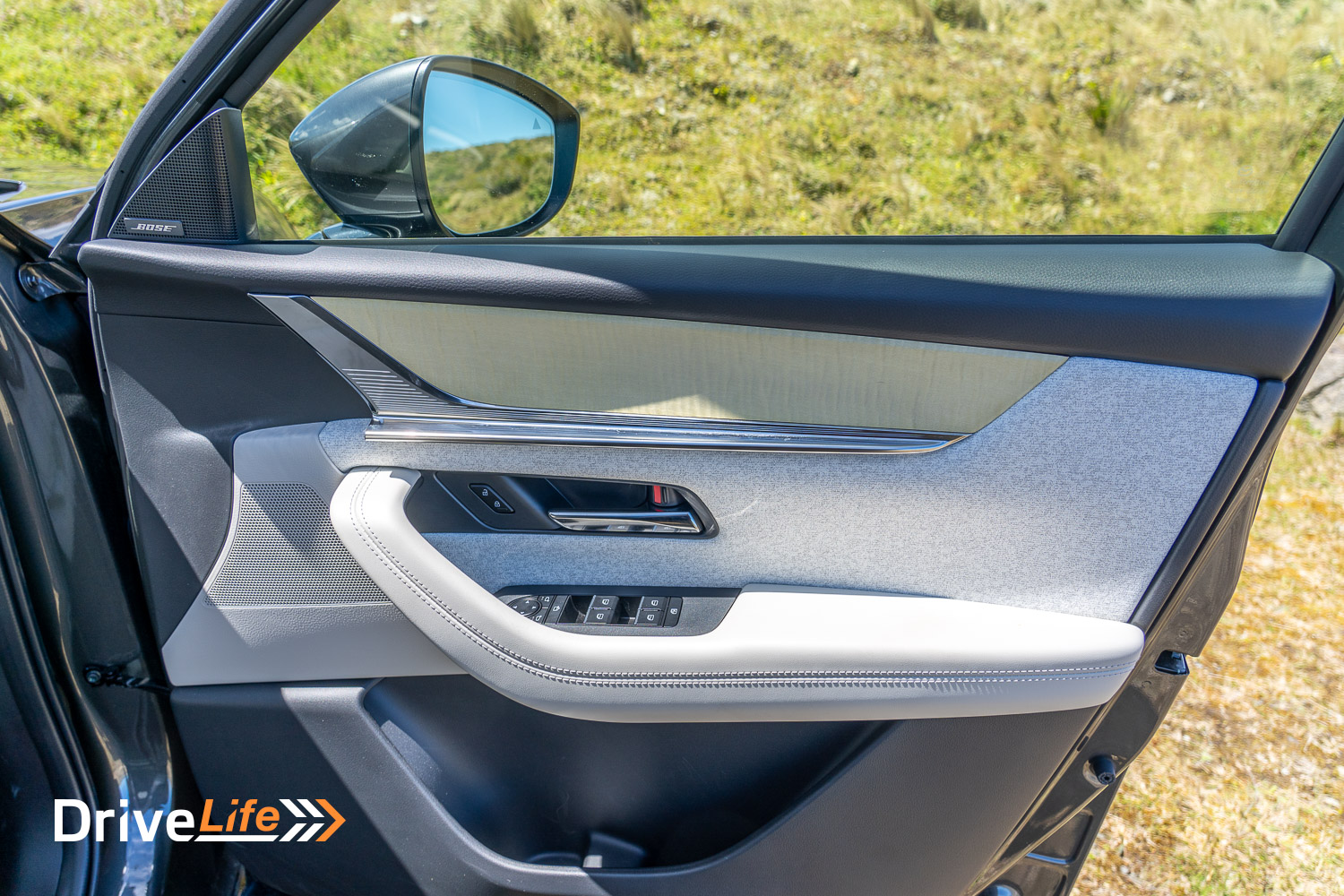
Traffic sign recognition was faultless too. We’ve had a bunch of test cars in a row where this has been a bit dodgy, so it was a relief to see Mazda still nails this. Mazda uses a system of traffic sign recognition with their adaptive cruise control whereby if you pass a new speed limit sign, you can press the ‘res’ button to change your speed to the new limit, be it faster or slower. It’s a great way to keep your speed in check.
Adaptive cruise control in either CX-60 does have one quirk.The CX-60 has a system that will slow the car down for corners when using adaptive cruise control. We’ve seen this before on other non-Mazdas, with varying levels of success. In the CX-60, the system will monitor the steering input and other factors like the car’s yaw and lateral G rates and will reduce the speed accordingly. That information also feeds into the Kinematic Posture Control (KPC) system to ensure the car remains balanced and composed in a corner. In practice, it doesn’t work that well.
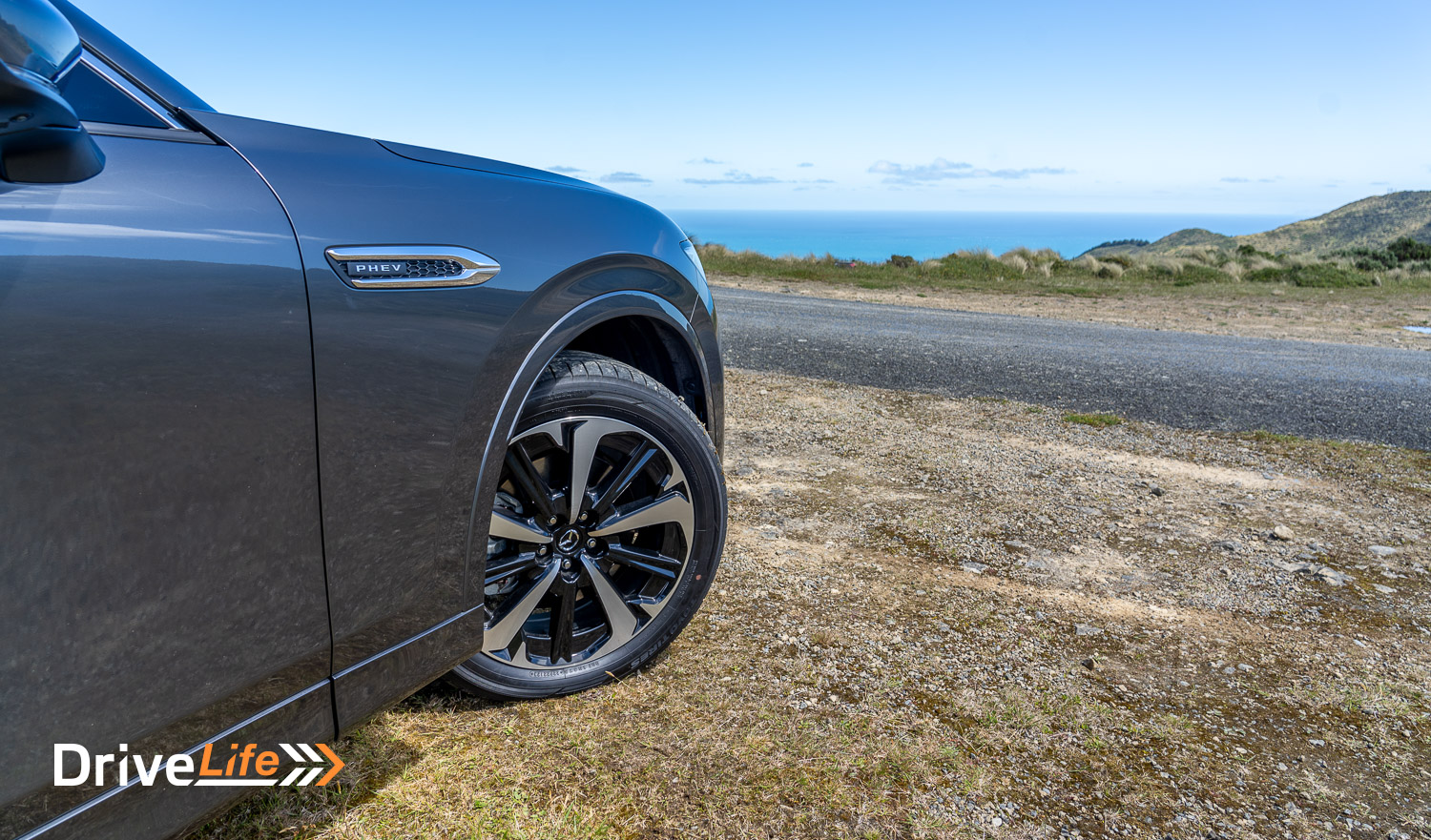
I found time and again that the system would kick in too late, generally when halfway around a bend. At that point, the car’s power would reduce and then the CX-60 would move into understeer since the power had dropped off. Reducing your speed halfway around a corner is not a good move. Hopefully, this system will improve over time. Note you can turn this system off.
All Mazda models have a reputation for being a bit of a driver’s car, almost European in this respect. You can see a few European models in our comparison chart, as that’s where the CX-60 really sits in the market. This is reflected in the handling of the CX-60; it does brilliantly for a car of its size and height. Grip is never an issue, and while there can be a reasonable amount of body roll if you push too hard through a corner, the car remains composed and safe. It’s not just the handling overall, but the CX-60 continues the Mazda tradition of a car that’s a bit of fun on a windy road.
Wind noise is well controlled, as is road noise – meaning I could easily hear that sound of the 3.3-litre turbo during the times when I had to wind the out to pass slow traffic. This engine howls at the red line. I couldn’t get enough of that noise, but cruising at a steady throttle and it’s a model of civility.
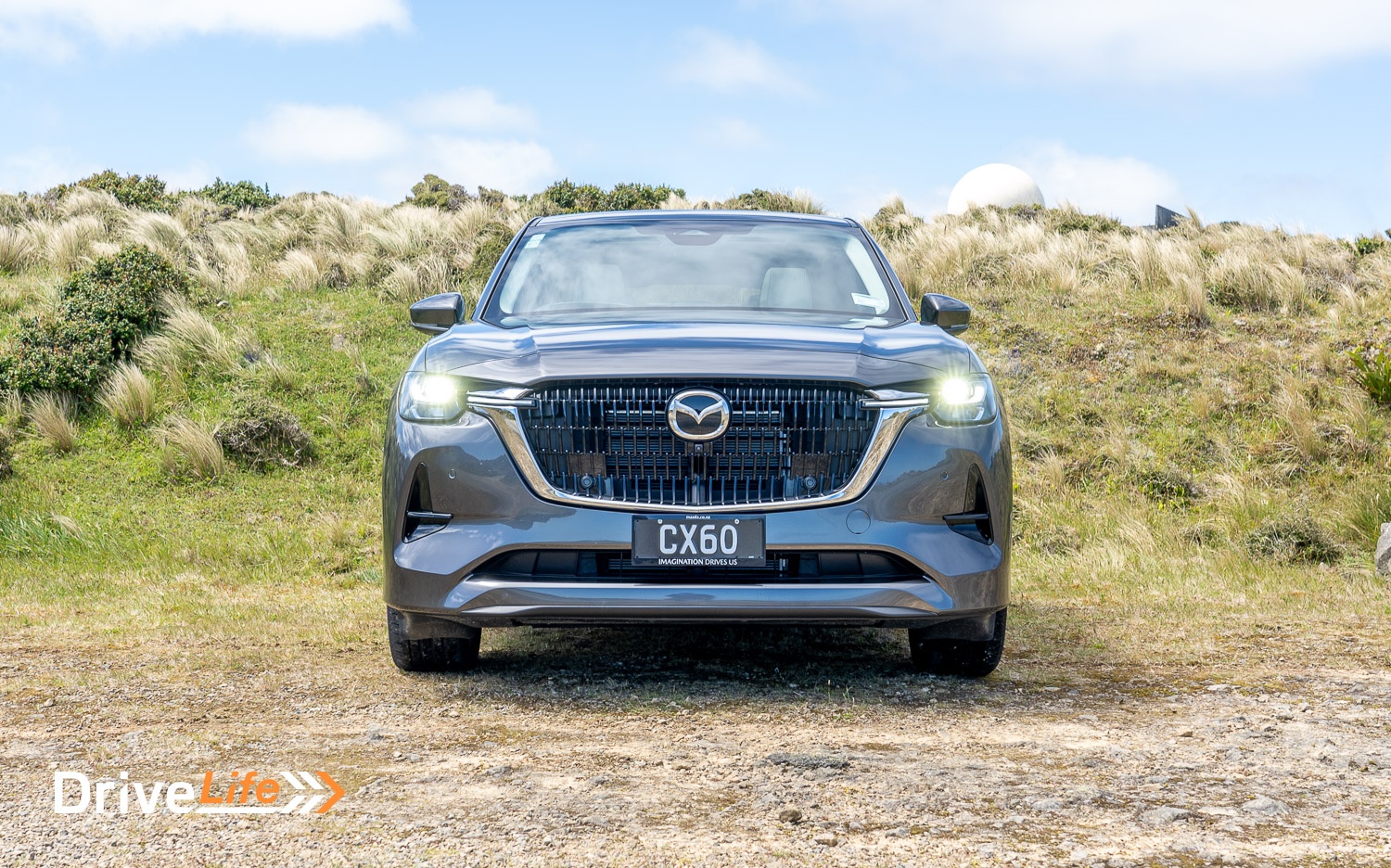
On getting to Hawera, I was very surprised to see my fuel economy sitting at 7.7L/100km. While Mazda suggests the 3.3 should return 7.8, to get that figure of 7.7 or even close to it was excellent. The 3.3-litre models of CX-60 use a 48-volt mild hybrid system to make the engine more efficient. I guess that was reflected in my fuel economy, but bear in mind, this is a very mild hybrid. While the engine may turn off at times, say going down a hill, a touch of the accelerator at any point will restart the engine. And since it’s a mild hybrid, the driver has no control over the hybrid part of the system- just get in a drive. Some people prefer this, anyway.
My weekend’s work was over, and I hit the road back to Wellington for the 300km, 4-hour drive. A few more revelations on this part of the trip. The seats are extremely comfortable, although there is only 2-way electric lumbar adjustment.
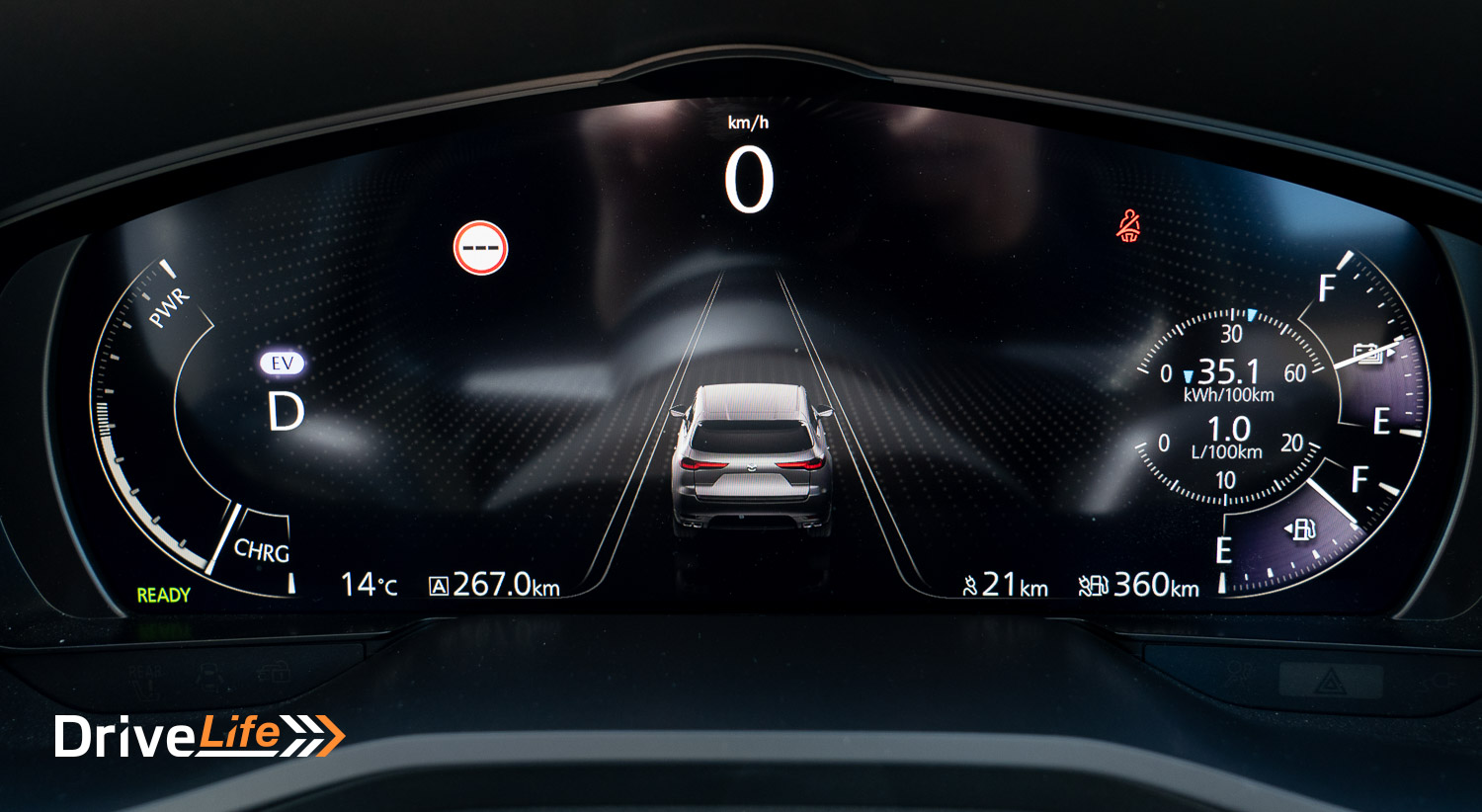
The dashboard is really clear and simple. There are no customisations you can pick from, but they aren’t needed – the dashboard is typically Mazda: simple and clear. Another clear display is the feed from the 360-degree camera system – it’s excellent.
On getting back to Wellington, my fuel economy was sitting at 7.5L/100km, another outstanding result. After driving the 3.3-litre model for almost 1,000km, my average fuel economy sat at 7.8L/100km. That’s a great figure for a large, powerful 6-cylinder turbo.
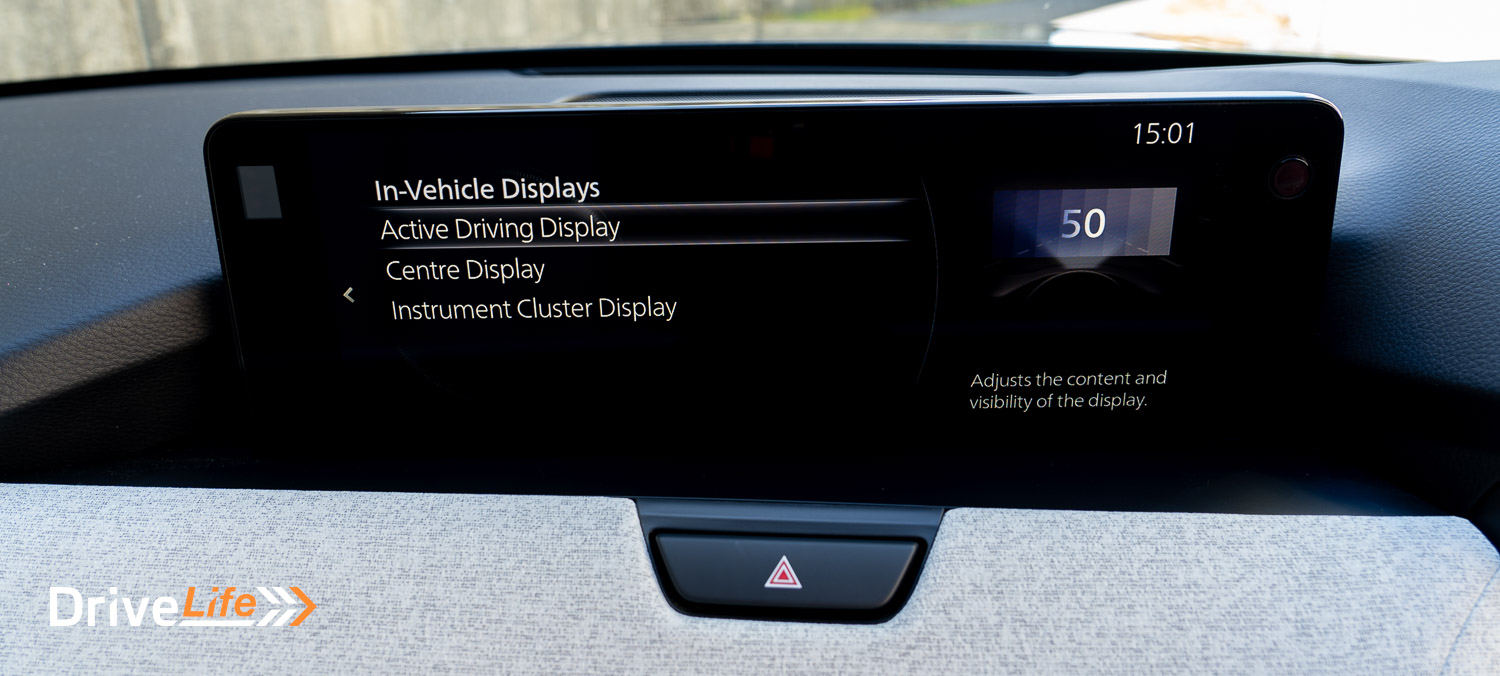
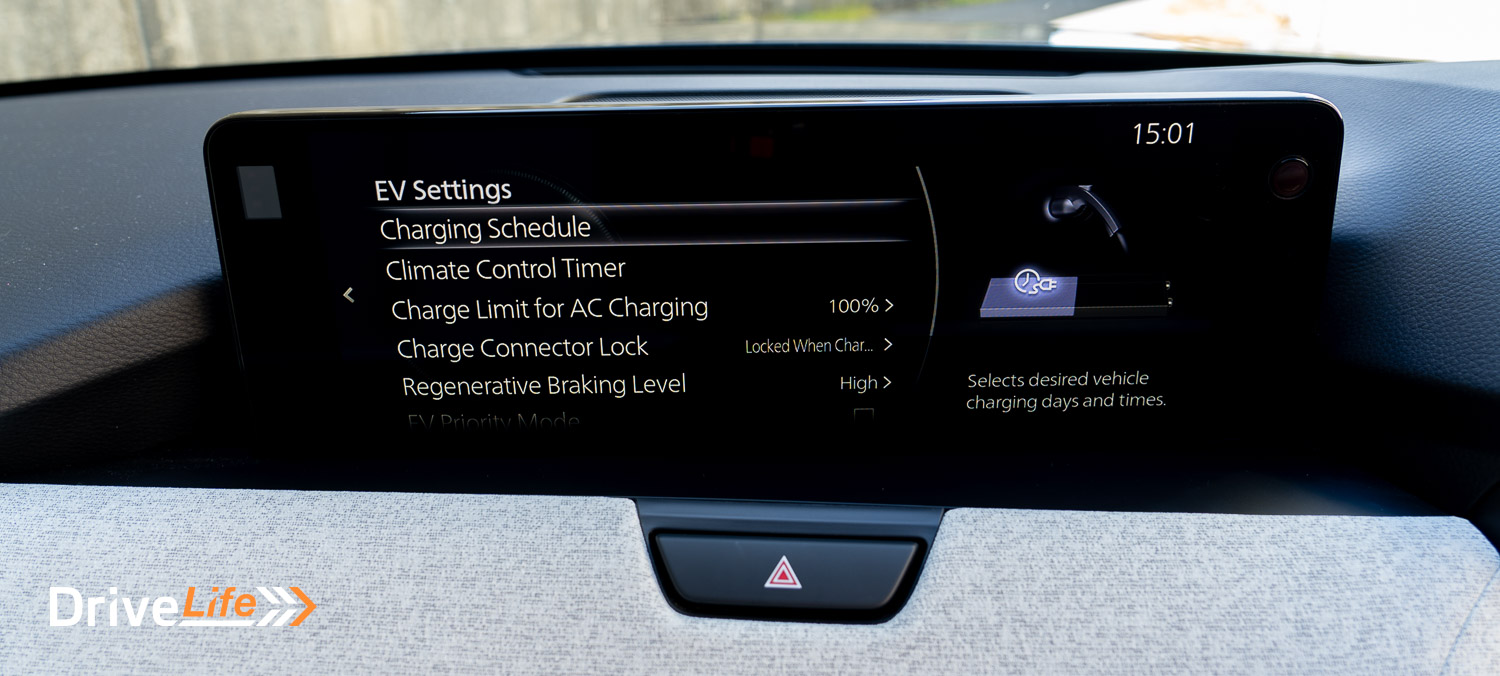
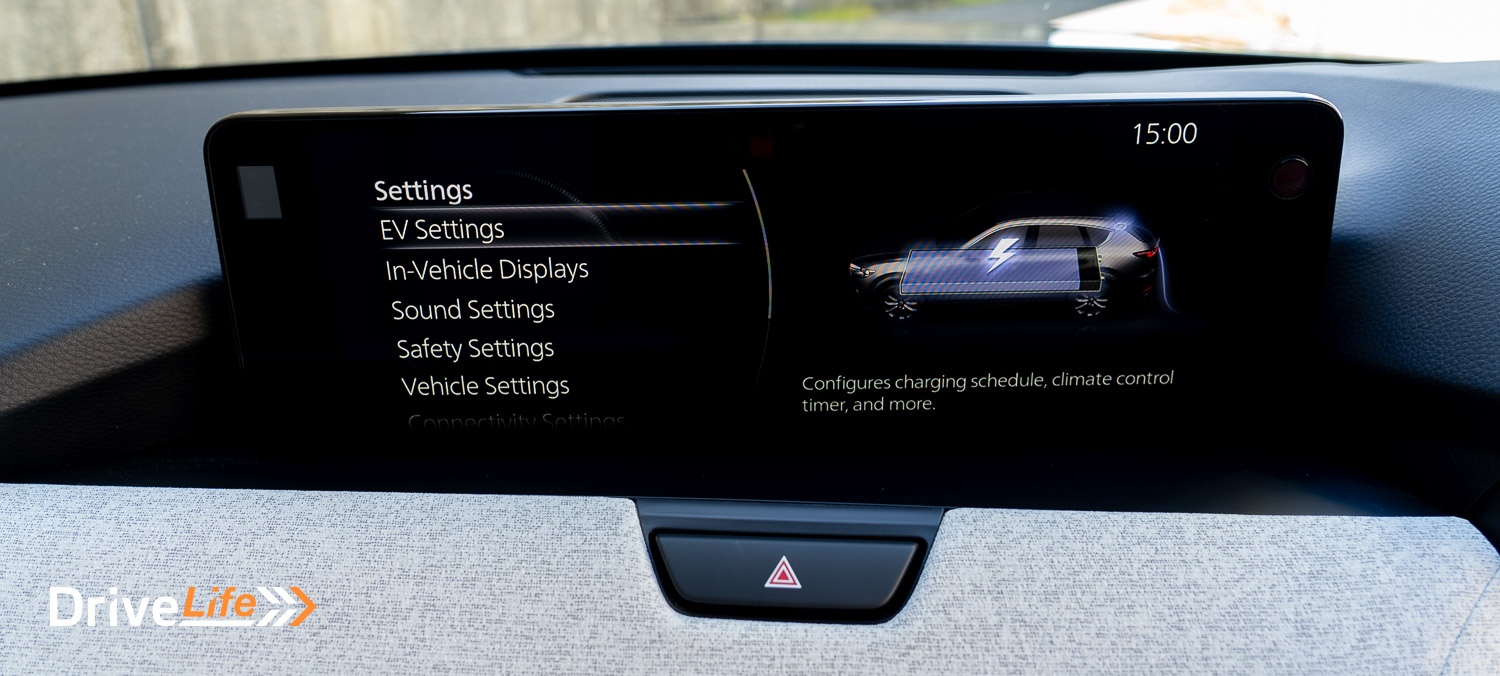
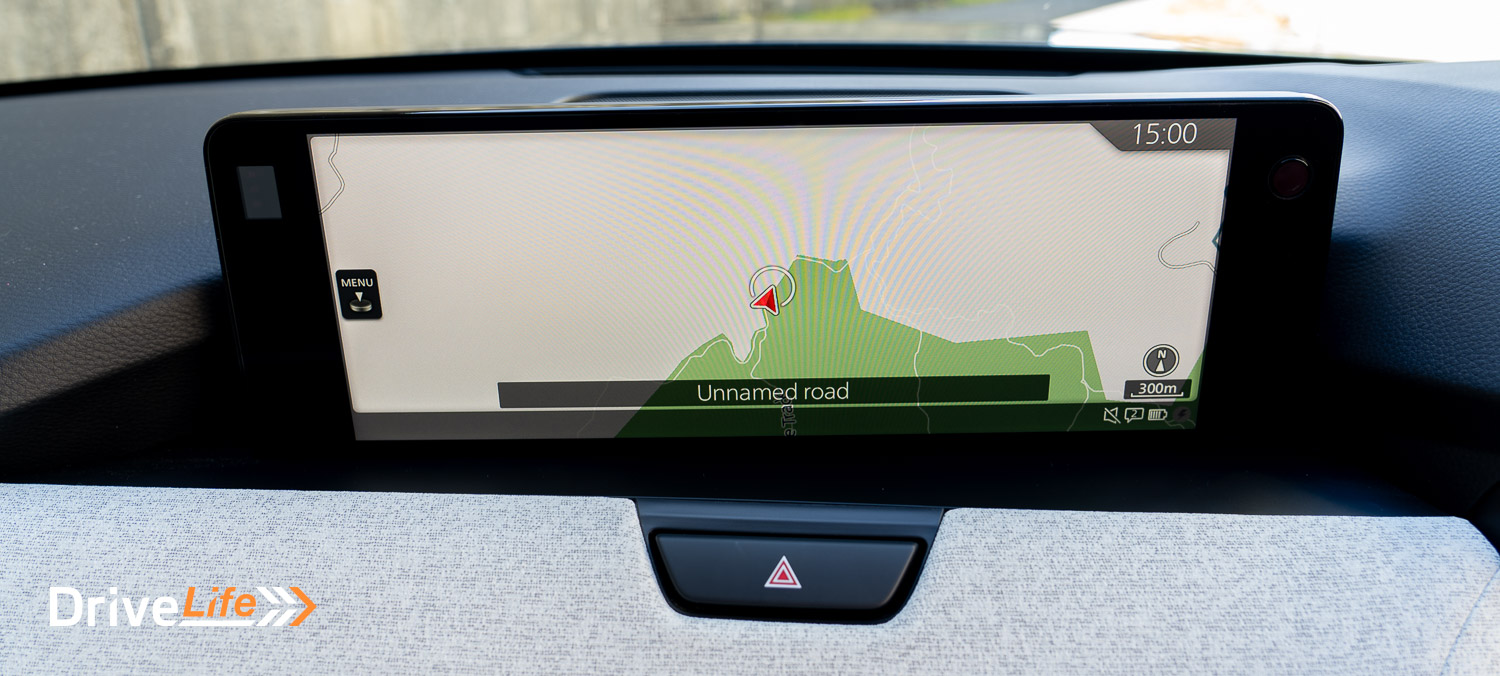
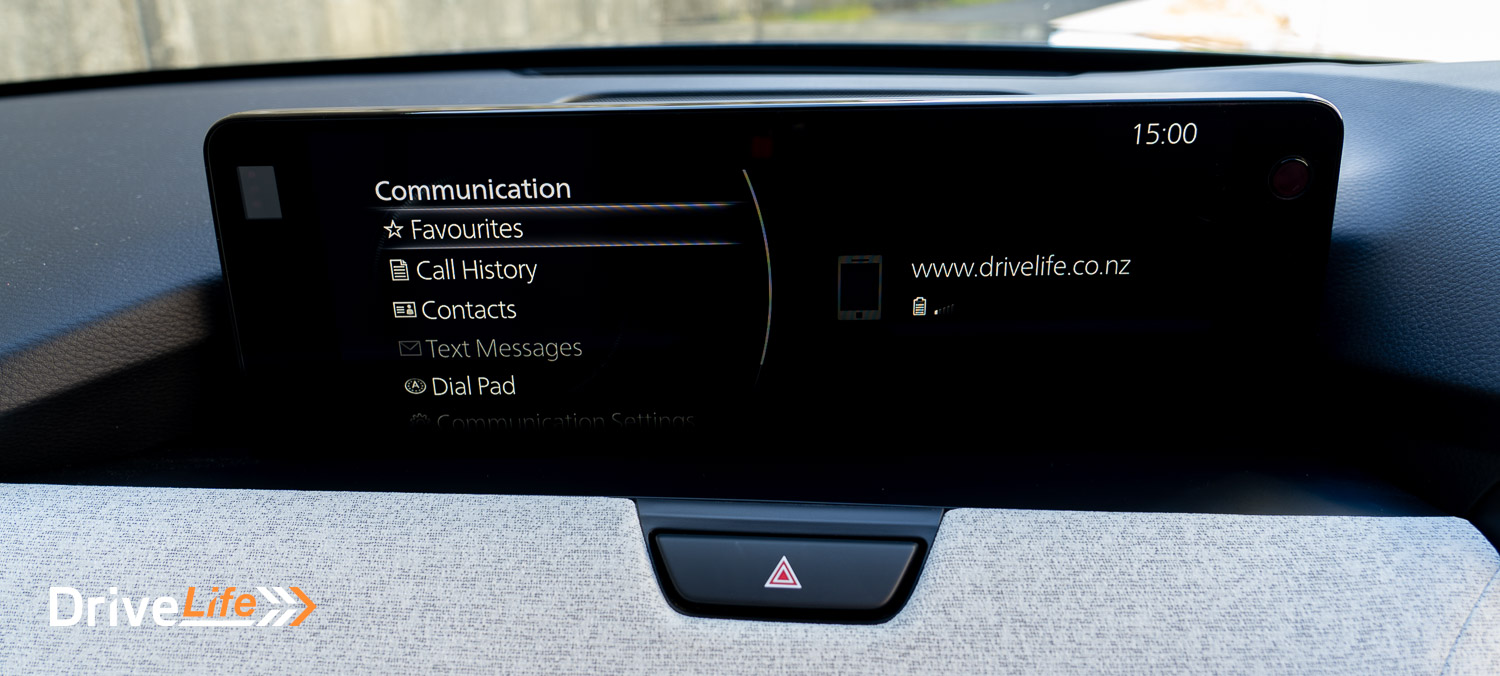
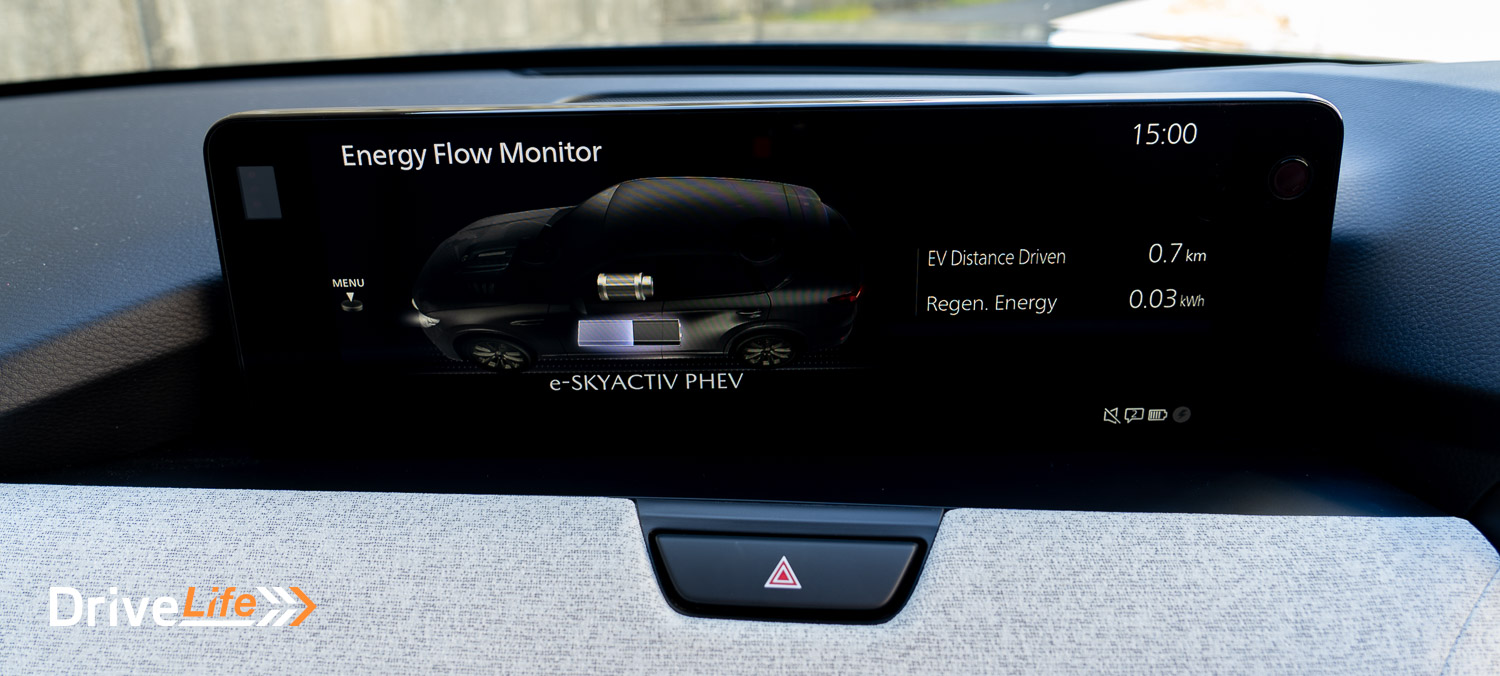
2023 Mazda CX-60 – Specifications
| Vehicle Type | 5-door medium-large SUV |
| Starting Price | Takami PHEV: $90,990 3.3 Homura: $81,990 |
| Price as Tested | Takami PHEV: $91,690 3.3 Homura: $81,990 |
| Engine | 2.5-litre, 4-cylinder petrol with plug-in hybrid assistance 3.3-litre, 6-cylinder turbo-petrol with mild-hybrid assistance |
| Power, Torque kW/Nm | Takami PEHV: 241/500 3.3 Homura: 209/450 |
| Transmission | 8-speed automatic |
| Spare Wheel | Space saver |
| Kerb Weight, Kg | Takami PHEV: 2,111 3.3 Homura: 1,949 |
| Length x Width x Height mm | 4740x1890x1686 |
| Boot Space / Cargo Capacity, Litres (seats up/seats down) | 477/1,726 |
| Fuel tank capacity, litres | Takami PHEV: 50 3.3 Homura: 58 |
| Fuel Economy, L/100km | Takami PHEV Advertised Spec – Combined – 2.1 Takami PHEV Real-World Test – Combined – 1.0 3.3 Homura: Advertised Spec – Combined – 7.4 3.3 Homura: Real-World Test – Combined – 7.8 Low Usage: 0-6 / Medium Usage 6-12 / High Usage 12+ |
| Towing Capacity Kg, unbraked/braked | 750/2,500 |
| Turning circle metres | 10.8 Small: 6-10m / Medium 10-12m / Large 12m+ |
| Warranty | 5 Years unlimited KM 5 Years Roadside Assist 5 Years/100,000km free servicing |
| Safety information | ANCAP Rating – 5 stars – Link Rightcar.govt.nz -5 Stars – CX6O |
Have you enjoyed this review? Be sure to join our monthly email newsletter list so you don’t miss a single car review!








